- 0 No item in your cart
- SUBSCRIPTION
- Classified Ads
- Technical Specifications
- Destinations
- Address book

- All the magazines
Catamaran basics The daggerboards: understanding and adjusting them

Article published on 01/04/2015
By Emmanuel van Deth
published in n°141 may / june
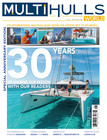
Having a catamaran with daggerboards means enjoying better pointing ability than an equivalent model equipped with fixed stub keels, which are inevitably shorter. It means that you can also optimize drag, speed and even safety. Partially integrated, with foils...an inventory of the daggerboards on our boats and how to use these appendages.
Create a notification for "Technical"
We will keep you posted on new articles on this subject.
1) All the Catanas are equipped with daggerboards. They are very long, and held structurally in their cases by the whole height of the hulls. Simple and strong, but beware of the significant windage in the raised position.
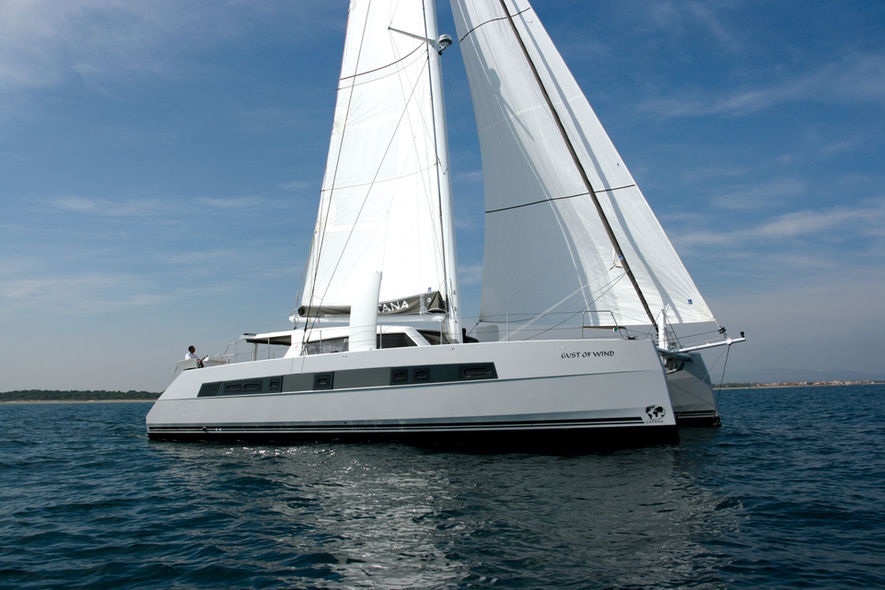
2) The latest Catana models are equipped with curved daggerboards. On the 59, the foil effect is worth 500kg at a speed of 15 knots.
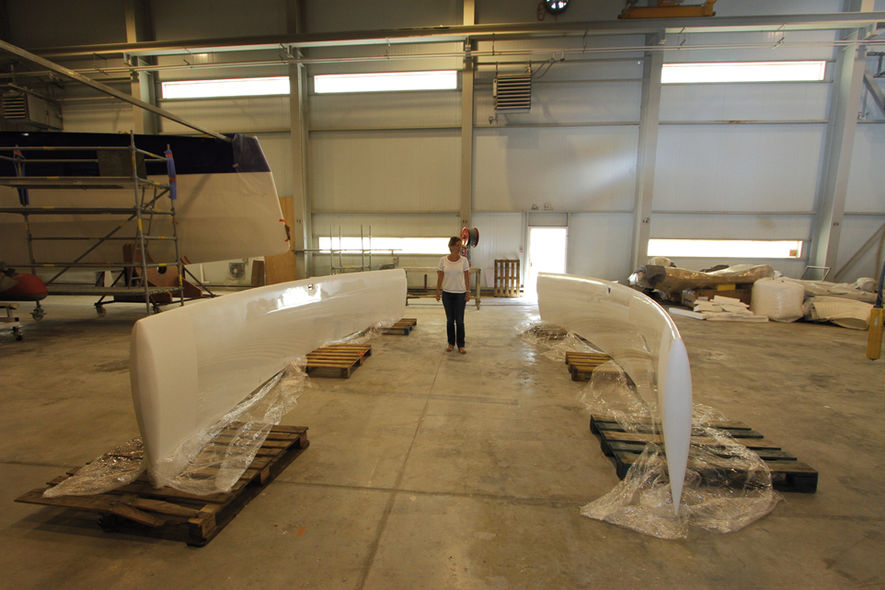
3) The latest Outremers have adopted shorter structural cases, to reduce the size of the daggerboards. Less windage in the raised position and less weight, but the construction is more complex…
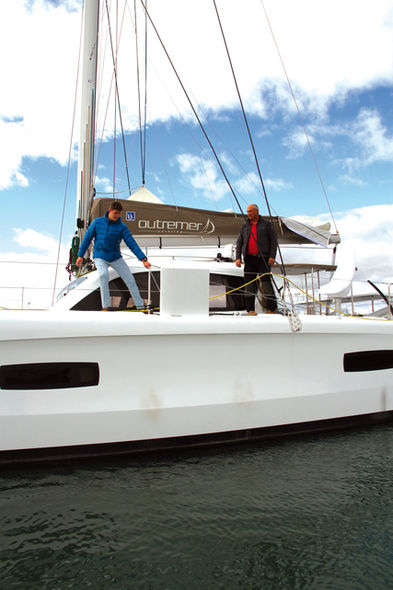
4) Numerous trimarans are also equipped with daggerboards/centerboards. They can be central and integrated into the accommodation, as aboard this Dash 750.
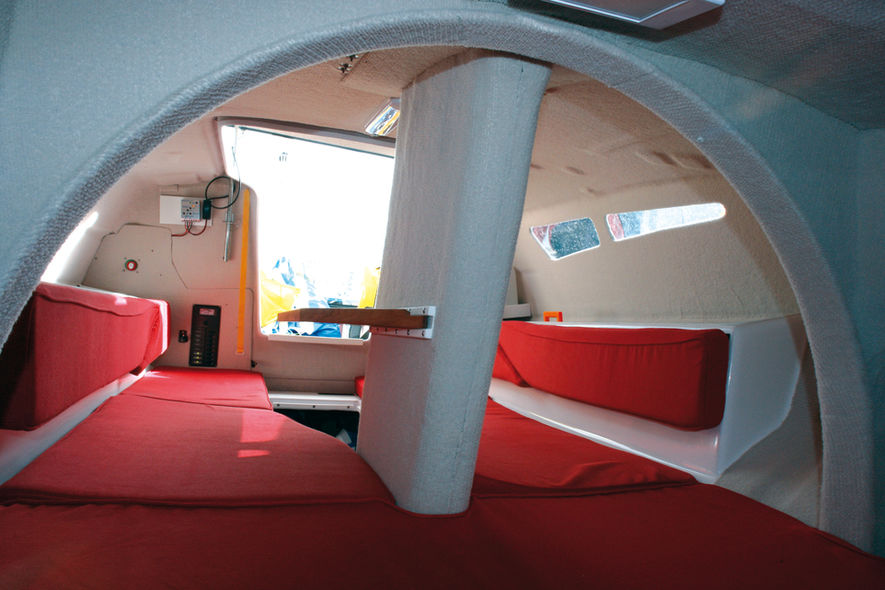
5) Other trimarans, such as the Tricat 25, are equipped with centerboards integrated into the floats.
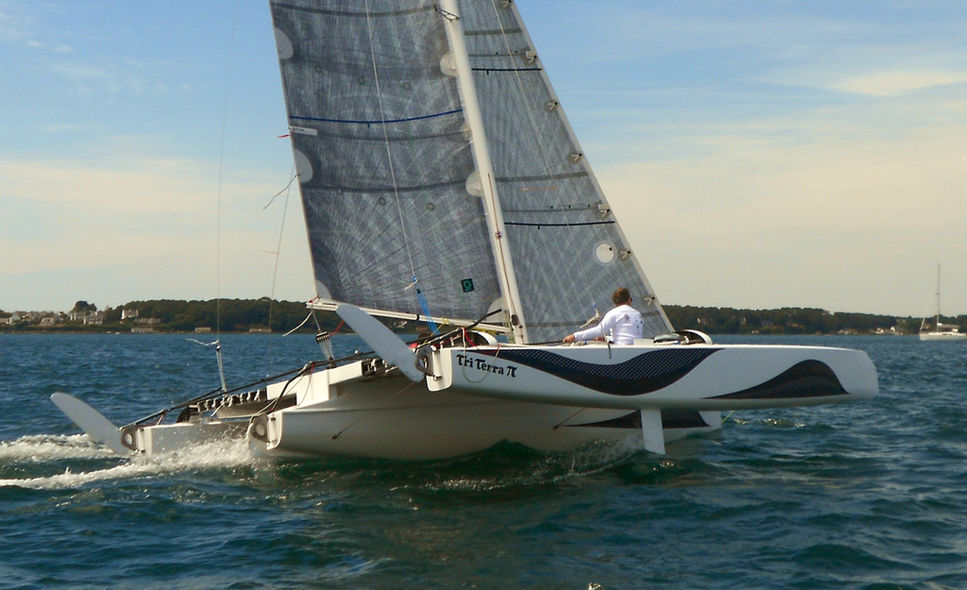
6) Builders such as Outremer provide stopper knots for the daggerboard control lines; a good way to judge the position when the daggerboard is not visible.
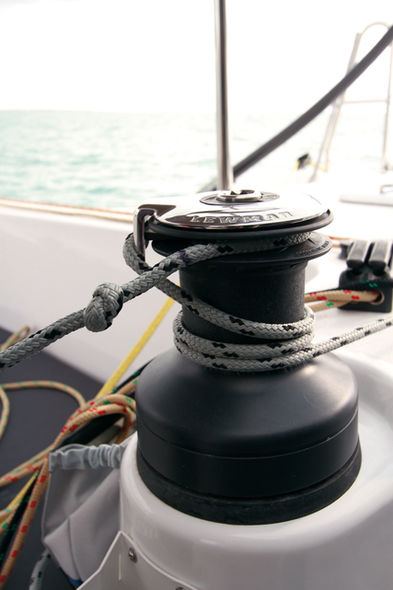
7) Once the daggerboard is out of its case, it is easier to judge: the lifelines are an excellent adjustment indicator!
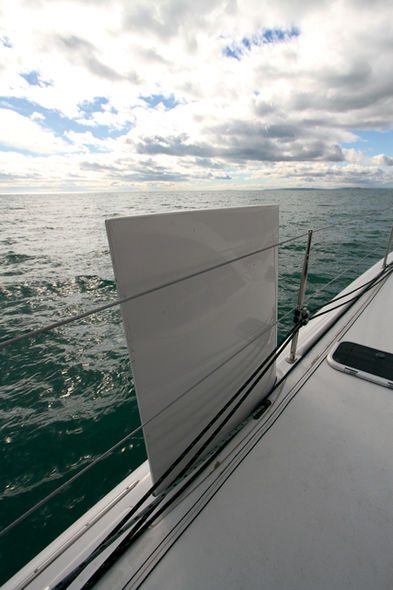
8) To windward in light weather, the daggerboards are fully lowered, to take advantage of maximum 'grip' on the water.
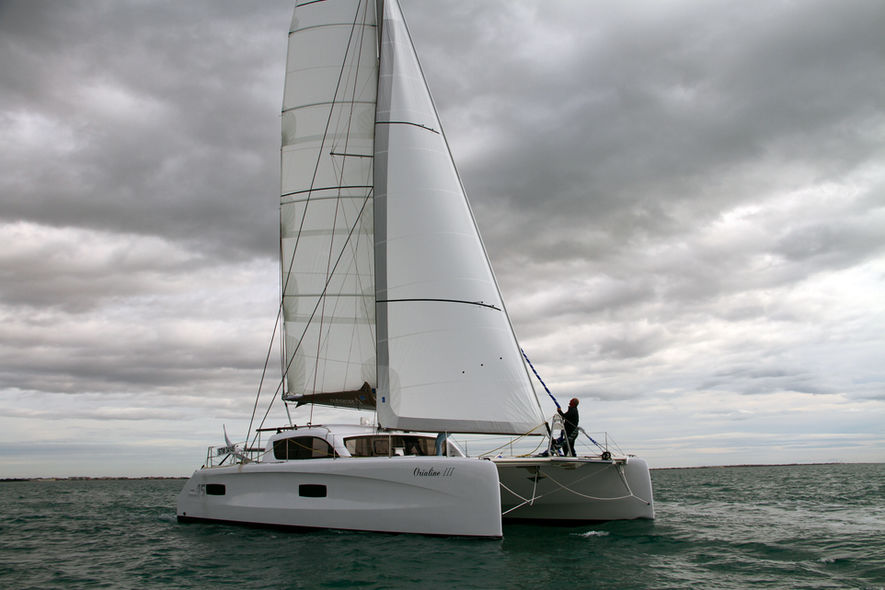
9) When the speed increases, it is worthwhile raising the windward board to optimize drag. Note: a daggerboard which moves is no use. Therefore we raise it!
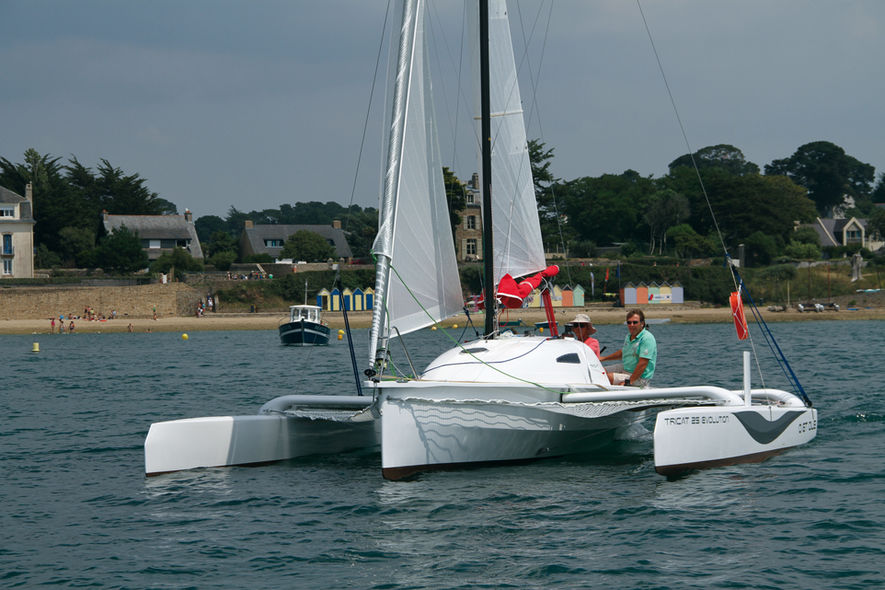
10) But for safety, it is preferable to raise the leeward appendage: in the case of a strong gust, the risk of the boat ‘tripping up’ is thus reduced. The compromise could be to raise both the daggerboards by half... It’s up to you to judge!
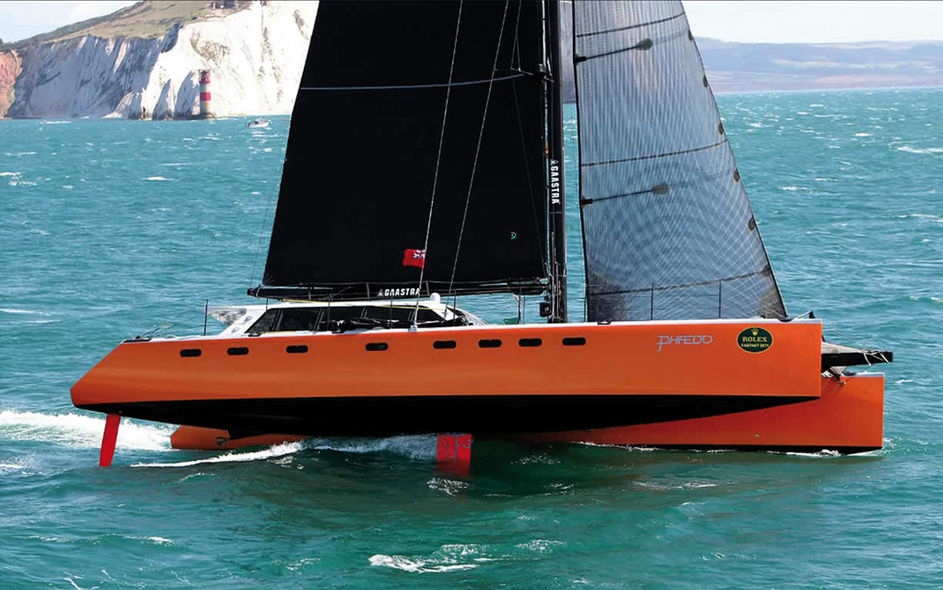
11) Downwind, the daggerboards are no longer useful, especially when the boat exceeds 10 knots... Keeping one third of the surface can however help the helmsman or the autopilot to steer a straighter course.
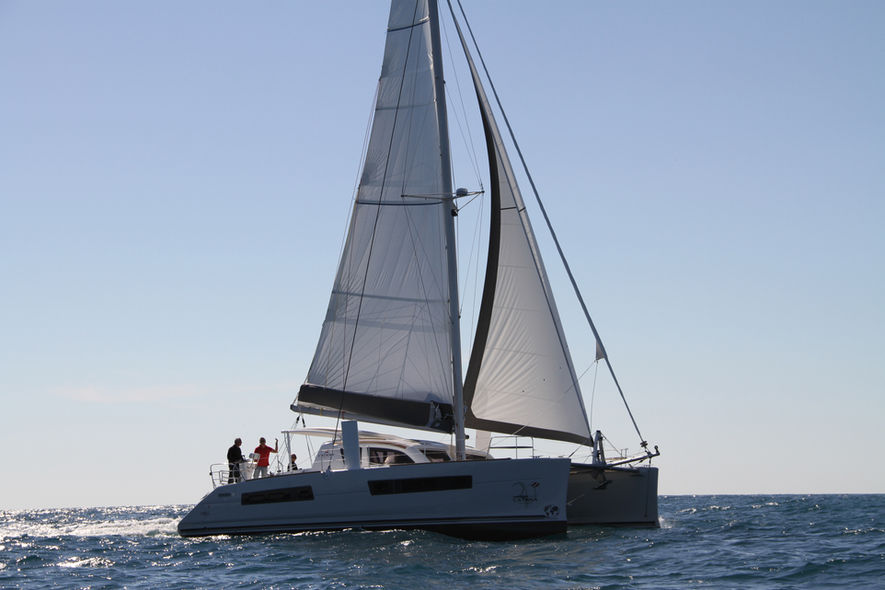
12) Heavy weather? Raise them completely so the hulls slide. On the other hand, with big seas from behind, (just like downwind in more manageable weather) it may be useful to keep a little daggerboard lowered to avoid yawing.
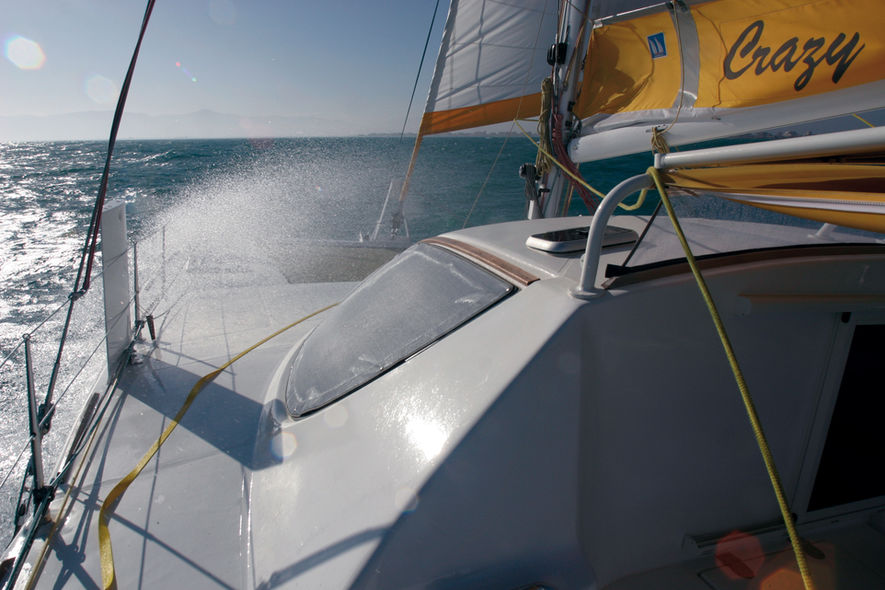
Subscribe to Multihulls World and get exclusive benefits.
Tags :
- préparation ,
- Catamaran basics
Did you like this article ?

Share this article
Most-read articles in the same category.
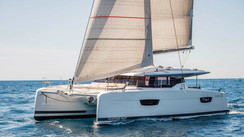
Bending on sails - Everything you need to know for making the most of your multihull
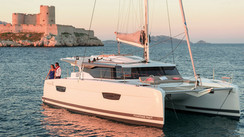
Maintenance - Saildrive legs
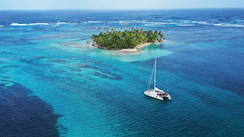
Anchoring - All you need to know about bridles
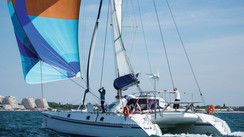
Multihulls Match Symmetrical Spinnakers - Parasailor Spinnaker VS Traditionnel Spinnaker
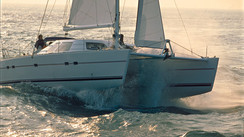
Forepeaks - How do you make the best use of them?
Everything you need to know about trampolines
What readers think.
Post a comment
No comments to show.
Follow us on
Vous avez ajouté " " à vos favoris., vous avez supprimé " " de vos favoris., in order to add this article to your favorites, please sign in..
- Outremer 45
- Outremer 4X
- Outremer 4.zero
- Outremer 52
- Outremer 55
- Outremer 51
- Outremer 5X
- All the Outremer Fleet
- Personalized support
- Blue Water Sailing Seminars
- Our concept
- The Outremer team
- Our commitments
- Construction principles
- Our catamaran services
- After-sales customer service & Quality control
- Offshore Connected Catamaran Maintenance
- Concierge Services
- Our owners’ stories
- FAQ – Outremer catamarans

- Brokerage: used catamarans for sale
- Privacy Policy
- Legal Notice
- Grand Large Yatching
Daggerboards: how to adjust them on your catamaran
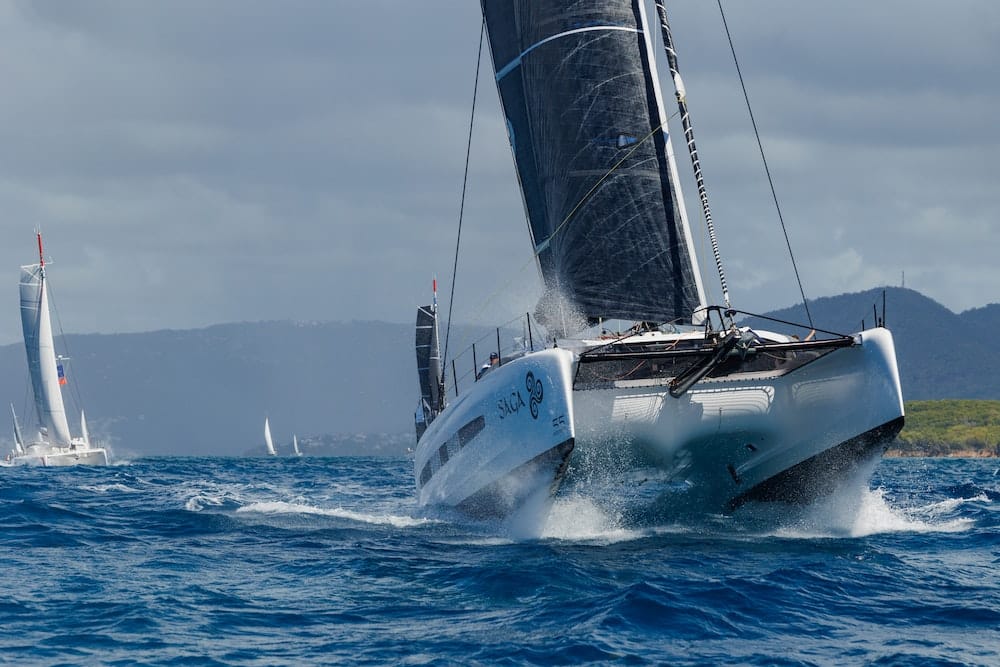
Author : Nikki Henderson
When I asked the Outremer Ladies’ community for suggestions on webinar topics, ‘Daggerboards’ was top of the list. I wasn’t surprised. I don’t think I’ve had a day out on an Outremer with prospective or current owners where daggerboards were not discussed.
It makes sense that there is a curiosity about daggerboards; using them properly is essential if you want your Outremer to perform. What is interesting though, is how confusing people find them.
One thing I’ve realised is that for some people, the issue is similar to my relationship with electronics (hate) and engineering (love). Things I cannot physically see are inherently cloaked in mystery and much more challenging for me to understand. This can be the case with daggerboards: they are hidden underwater and so are often forgotten or misunderstood.
The other reason that daggerboards can be confusing is that they affect not just the performance of a catamaran, but also the safety. Sometimes the theories contradict each other and lead to conflicting advice as to the right and wrong way to use them. In fact, there is no one ‘rule’ about daggerboards. The key, as with anything on a boat, is to understand the reasoning behind the basic daggerboard practices, so that you can make your own decision based on your own unique circumstances that you encounter at any particular time.
I hope this blog will help you build this critical foundation of understanding so that you can set sail safely and with confidence. Daggerboards – like sail trim – is a subject of continual learning. See this as step 1 in the life-long journey.
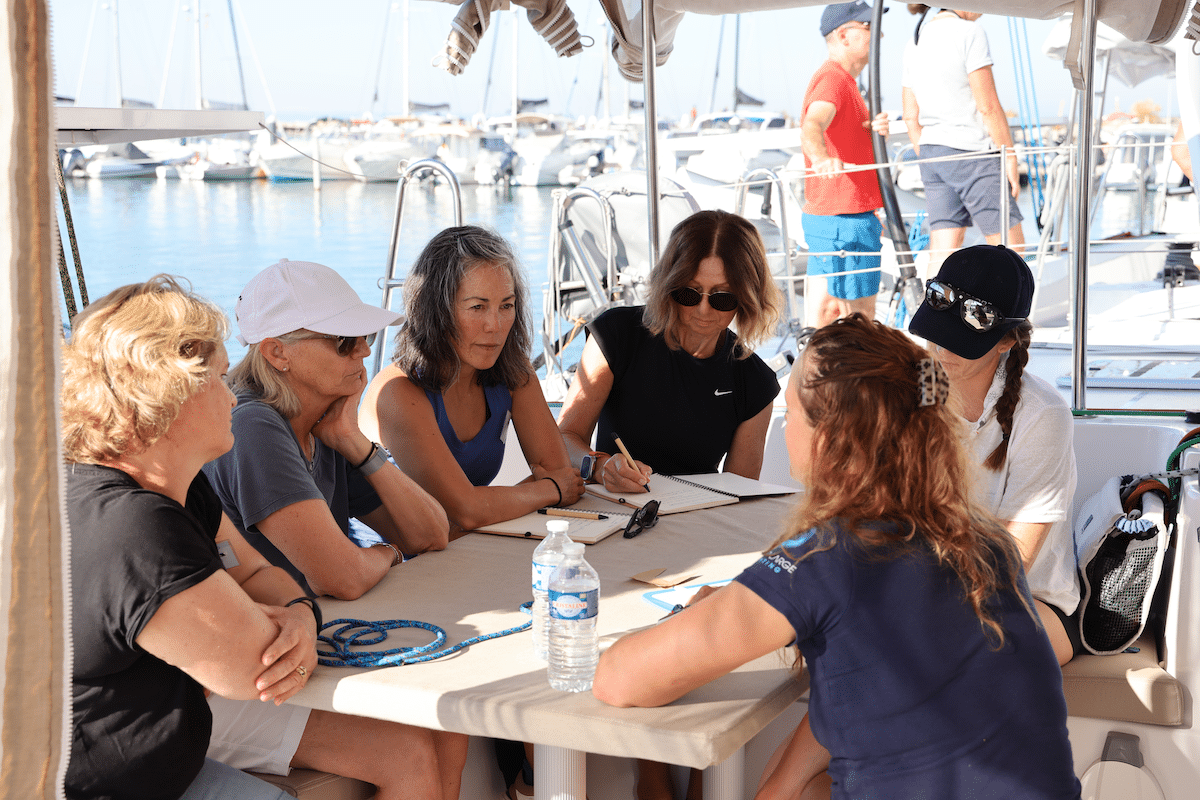
Catamaran daggerboards: how should they be adjusted for optimum sailing?
Daggerboards are best thought of as an ‘underwater sail’ – sometimes called a ‘foil’. Just as a sail above the water needs trimming – so does the sail under the water. But unlike the sail above the water, the daggerboard only has one trim option: how much of it is exposed below the hull.
When sailing upwind the daggerboards provide resistance and lift under the water to balance out the sideways effort force from the sail above the water. In more simple terms, daggerboards help the boat move forward rather than sideways when sailing upwind. Therefore, when sailing upwind, the assumed best practice is to have the daggerboards down. [UP-wind = DOWN-board]
When sailing downwind, the effort force from the sail works almost entirely in the direction you need the boat to go. Therefore, you do not need the resistance under the water from the daggerboard to help with the direction. In fact, it will probably hinder you from sailing deep downwind and slow you down. Therefore, when sailing downwind, the assumed best practice is to have the daggerboards up. [DOWN-wind = UP-board]
Generally, when sailing with wind on the beam – a good ‘go-to’ trim set up is one that is somewhere in the middle of downwind and upwind trim. Therefore, a good starting point for a beam reach would be to lift the daggerboards half-way up.
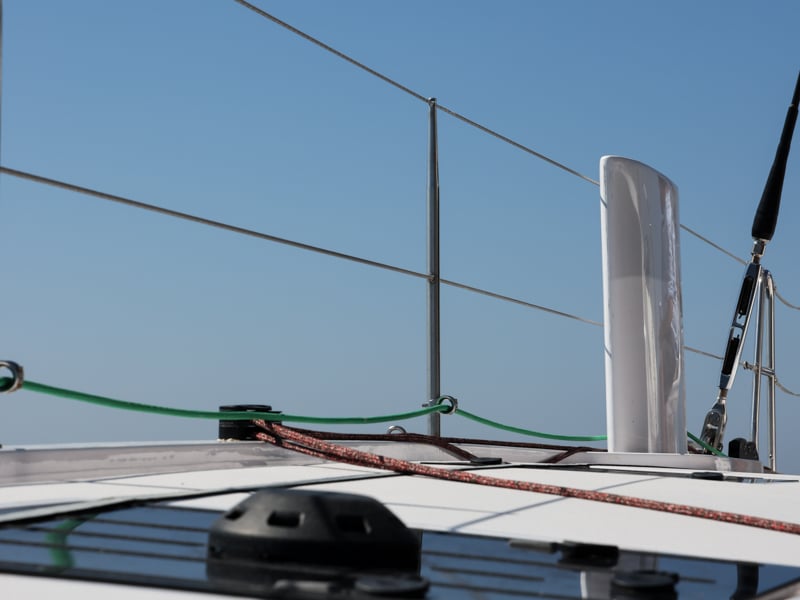
Which catamaran daggerboard for which sailing conditions?
For any competent dinghy sailors who understand daggerboards, this is the most common question as they are typically used to using only one!
An important key principle, is that a daggerboard is only effective when it is submerged in the water. Therefore, if you were sailing the boat purely for performance in a flat sea, you would always need to be trimming at least the leeward one. If the windward hull lifts slightly here and there (which it does fractionally in any substantial wind) then the windward daggerboard is not working efficiently.
Do you drop the windward board? In relation to performance, this depends on how much underwater resistance you need.
In very light winds, the standard practice is to lift the windward daggerboard all the way and only trim the leeward board. When both daggerboards are down, (for simplicity) there is now double the ‘underwater sail’ area. This would likely imbalance how much power there is from the light winds on the sail above the water, and literally ‘drag’ the boat and slow her down.
As the winds increase, there may be a time where you feel you want more underwater resistance, and you could consider lowering the windward board as well. You might find your course over ground improves. Then it was a good decision. If your speed decreases, it might be creating too much drag and you should lift it back up.
If the wind continues to increase further, it is likely you will choose to reef the main. If we return to the concept of the daggerboard being the ‘underwater sail’, if you reef the main, then consider reefing the daggerboard and lifting some up slightly with each reef you put in upwind to keep the boat balanced.
You may be wondering how such a tiny thing as a daggerboard could balance out the enormous sail area of a main sail. The answer here is that water is a much denser fluid than air, and so the daggerboard needs much less area to create the same force than it would do if it were in air.
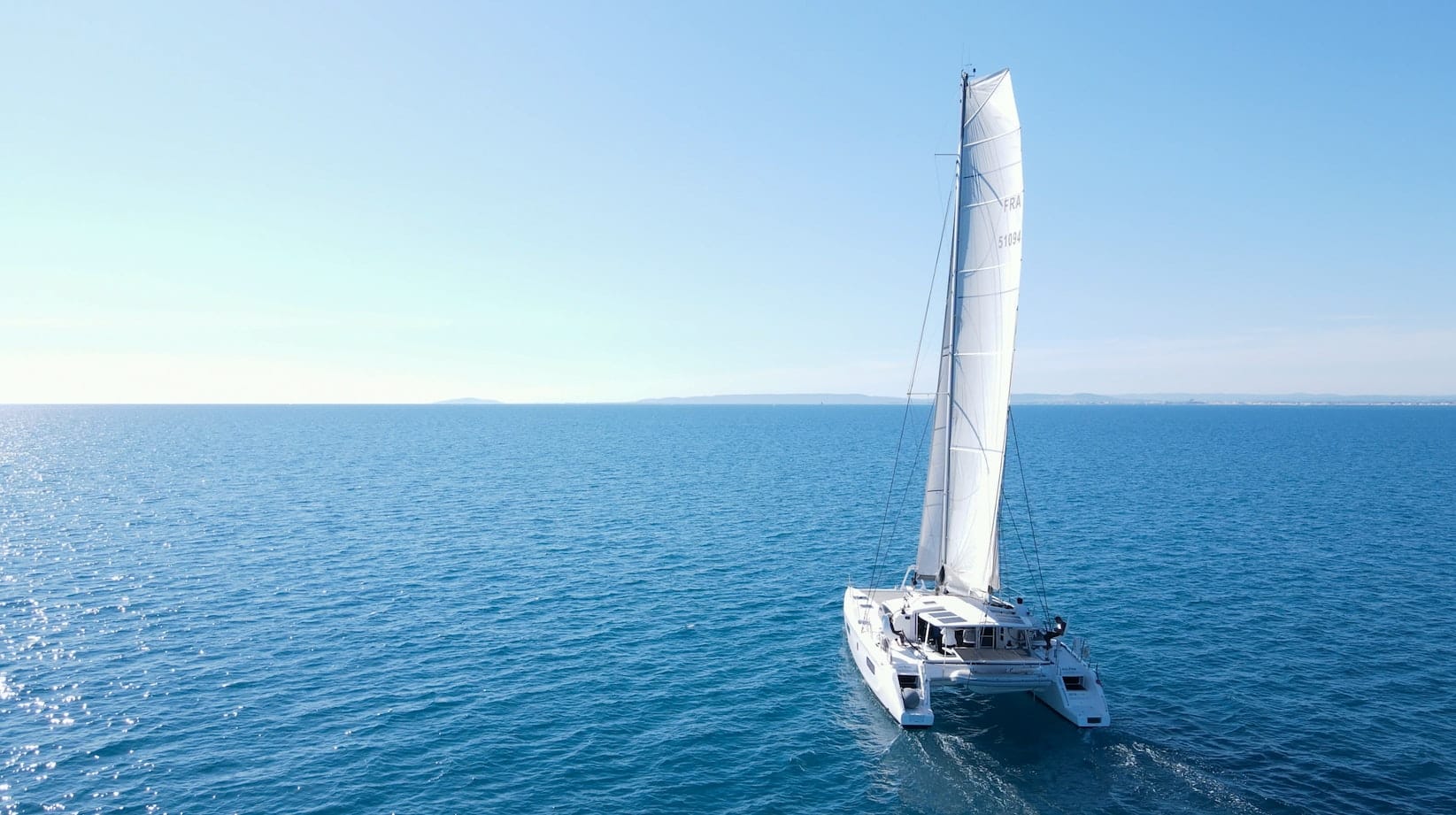
Safety at sea: adjusting daggerboards to avoid risks
This is where things start to get a little confusing.
The leeward daggerboard being down will increase the risk of ‘tripping up’. Therefore, in any significant sea state – or possible impending increase in wind/seastate such as if you are close to a mountainous shore line – where you feel that the hull is, or may, lift a lot, it is in fact safer to lift the leeward daggerboard and only use the windward one. Be aware that you will see a drop in performance as this contradicts the performance best practice of trimming the leeward board and not the windward.
The safest option entirely in very large sea states where the sea is actually tilting the boat significantly from side to side as she rolls down waves is to lift both daggerboards, so you float along waves like a raft.
‘Tripping up’ is a phrase used a lot and in fact sometimes misunderstood. To explain what it means: if there is wind/waves coming from the side of the boat and the windward hull lifts slightly in a wave, or there is a gust and the sail powers the boat forward – the leeward hull can ‘dig in’ to a wave and trip the boat up. The best way to imagine this is imagine getting one of your shoelaces on one of your feet stuck but the rest of your body is still walking. You will fall over. Same with the boat.
A converse argument to lifting the daggerboards up, is that dropping both of them will protect the underside of the boat – from grounding, or from hitting a submerged object. Having both daggerboards partially down can protect the propellor. Having them at ‘deck level’ can protect the rudder. In other words, if you hit something then it will hit the daggerboard before the more fragile underwater equipment.
Another argument against lifting the daggerboards entirely, is that with no daggerboards, your rudder is doing all the ‘resistance-work’. It is hard to believe, but it also acts as a very tiny underwater sail too. There will be a huge load on the rudder with no daggerboard at all and this risk is probably not worth the gain in speed on a long downwind ocean crossing. One way to spot if the rudder is working too hard is just look at your autopilot rudder angle – if it’s maxing out and having to work very hard to keep the boat going straight then you probably have too much sideways slip. It’s a bit like the boat is sailing on an ice rink. In that case, I’d recommend putting both of them down a touch. This will benefit both the ruder and the autopilot (therefore power consumption).
(Read our Safe Sailing article to learn more about safety on board)
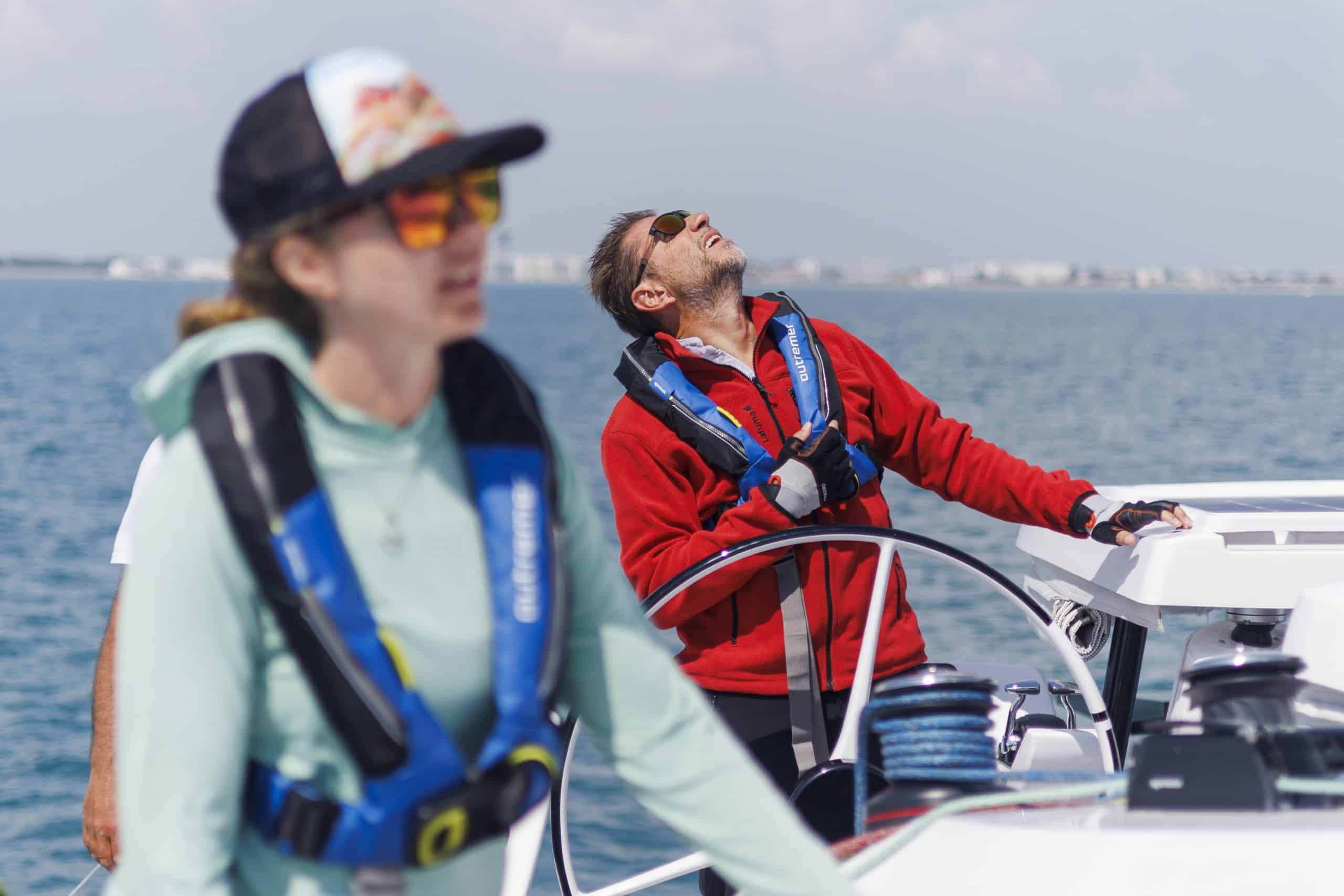
Using daggerboards is a balancing act! Boat weight, weight distribution, sail area, wind strength, sea state, sail trim are all things that effect the decision for how to use the daggerboards: how much daggerboard to use and which one (or both) to use. This is why it’s not an exact ‘one size fits all’ rule and anyone who tells you so is probably oversimplifying it which could lead to a dangerous sitaution. But start using them and see how the boat feels. The beauty of buying an Outremer is that if you keep her lightweight and trimmed well, then she will talk to you and tell you what feels good. Don’t believe me? Try sailing a brand-new Outremer out of the factory before she has anything on – then compare it to one with four peoples’ life belongings on – and you will see what I mean. 😉
Continue navigation
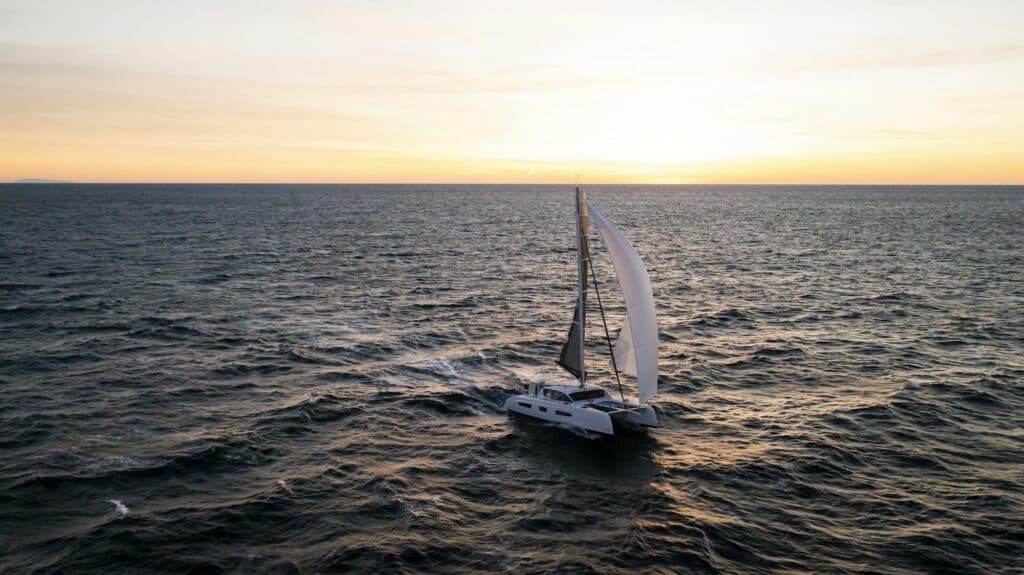
Why sail around the world in a catamaran rather than a monohull?
Sailing around the world is a dream come true: you discover the world to the rhythm of the wind and the stopovers, exploring new destinations every day as you sail. If you’re just starting to read this article, you’re probably nurturing this project. Are you planning to sail around the globe? Then the choice of ship for your next voyage is crucial.

The Importance of Defining Success
In the Autumn of 2023, I ran a ‘Webinars for Women’ mini-series on transatlantic preparations. The first session was titled: “How to approach transatlantic preparation.” As I zoomed out of the nitty gritty of canned food recipes, spare parts inventories, and preventative sail repair and took a broader look at the framework for a successful crossing, I homed in on what I think the first and most important step is: defining your goal.

Sailing in the Bahamas : unforgettable stopovers
The Bahamas Islands are a dream destination to explore under sail! In the heart of the Caribbean Sea, the archipelago offers the chance to enjoy sailing through splendid scenery, pleasant places to stop off and memorable activities. In this article, the Outremer team tells you what they consider to be the essential stages of a catamaran cruise in the Bahamas.

What Are Daggerboards on a Catamaran? (An In-Depth Look)
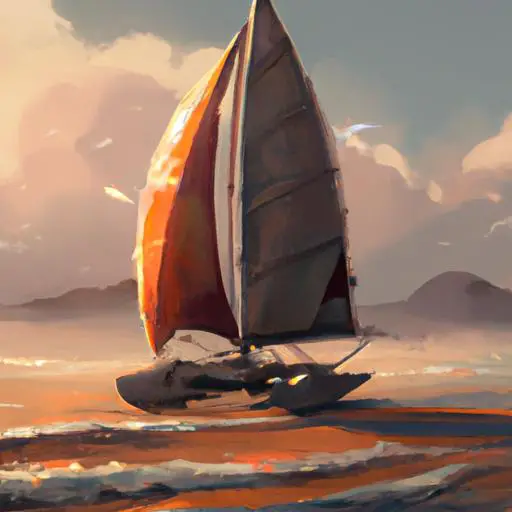
Have you ever wondered how catamarans move so fast and efficiently through the water? The answer lies in daggerboards, a unique and essential feature of these vessels.
Many sailors consider daggerboards to be one of the key advantages of sailing on a catamaran over a monohull sailboat.
If you’re curious to learn more about the science behind this nautical feature, then this article is for you.
Here, we’ll dive into the details of what daggerboards are, how they work, the benefits they offer, the types of daggerboards, and the best practices for maintenance and performance.
By the end, you’ll be an expert on the topic and be able to make an informed decision about the best type of daggerboard for your vessel.
Table of Contents
Short Answer
Daggerboards are vertical boards on a catamaran that can be raised and lowered to provide lateral resistance and stability to the boat.
When the daggerboards are lowered, they provide more stability and can help the catamaran sail closer to the wind.
When they are raised, the catamaran has less resistance and can move faster.
Daggerboards are an important part of a catamaran’s design, as they provide stability and control in difficult weather conditions.
What Are Daggerboards?
Daggerboards are a vertical fin-like structure found on a catamaran, which is a type of sailboat with two hulls of equal size.
Daggerboards are typically located on the centerline of the boat and can be raised and lowered at the skipper’s discretion.
This allows the skipper to adjust the center of effort on the boat, which in turn affects the boat’s maneuverability and control.
At the most basic level, daggerboards provide additional lift and stability to a catamaran, allowing for improved performance in light winds.
They work by creating forward thrust and lift, helping the boat move through the water more efficiently and allowing it to make tighter turns.
Daggerboards also help to reduce leeway, which is the tendency of a boat to drift sideways in the water due to the wind pushing against its sails.
By positioning the daggerboard at an angle, the skipper can reduce the amount of leeway the boat experiences, allowing it to maintain a more consistent course.
Overall, daggerboards are a key component of sailing catamarans and can have a significant impact on the performance of the boat.
With the right setup, they can make a boat faster, more maneuverable, and easier to control in a variety of conditions.
For sailors looking to get the most out of their catamaran, understanding how to use daggerboards is essential.
How Daggerboards Work

Daggerboards, also known as centerboards, are a vertical fin-like structure found on a catamaran.
They are typically located on the centerline of the boat and can be raised and lowered at the skippers discretion.
Daggerboards are designed to provide the catamaran with additional lift and stability in light wind conditions.
This helps to improve the performance of the catamaran by adjusting the center of effort on the boat, allowing for greater maneuverability and control.
When the daggerboards are lowered, they act as an underwater keel, providing additional stability and lift.
This helps the catamaran to cut through the water more efficiently, allowing it to move faster and with greater control.
The daggerboards also help to prevent the boat from drifting sideways in the wind, which can be a common issue with monohulls.
The daggerboards also help to reduce the amount of heeling (leaning) experienced when sailing upwind, making the sailing experience more comfortable and enjoyable.
When the daggerboards are raised, the catamaran will be more maneuverable and have improved performance in light wind conditions.
This is due to the reduced drag caused by the daggerboards not being in the water.
The raised daggerboards will also help to reduce the amount of heeling experienced when sailing downwind, making the sailing experience more comfortable and enjoyable.
The use of daggerboards can significantly improve the performance of a catamaran in light wind conditions and is a key component of sailing catamarans.
By raising and lowering the daggerboards, the skipper can adjust the center of effort on the boat, allowing for greater maneuverability and control.
The Benefits of Daggerboards
Daggerboards are an essential part of sailing catamarans for a number of reasons.
The most obvious benefit of having daggerboards on a catamaran is that they provide additional lift and stability, allowing for improved performance in light winds.
By raising and lowering the daggerboards, the skipper can adjust the center of effort on the boat, giving them greater control over the boat’s maneuverability.
This can be advantageous in tricky situations, such as sailing close-hauled or in tight spaces.
Additionally, daggerboards can help reduce drag in certain conditions.
By raising the daggerboards, the boat can be steered more efficiently by using the hulls to provide lift instead of the daggerboards, which can result in less drag and improved performance.
Finally, daggerboards can help improve the safety of a catamaran.
In rough seas, daggerboards can provide additional stability, helping to keep the boat upright and preventing it from capsizing or being damaged.
This can be especially beneficial when sailing in unfamiliar waters or in bad weather conditions.
In summary, daggerboards are an invaluable component of sailing catamarans.
They provide added lift and stability, can be used to adjust the center of effort on the boat, reduce drag, and improve the safety of the boat.
With all these features, it’s no wonder that daggerboards are a must-have for any serious catamaran sailor.
Types of Daggerboards

When it comes to daggerboards, there are two main types that can be found on a catamaran: retractable and fixed. Retractable daggerboards are typically made of fiberglass and can be raised and lowered at the skipper’s discretion. This allows the skipper to adjust the center of effort of the boat, providing improved maneuverability and control. Fixed daggerboards are usually made of wood or metal and are permanently mounted in the centerline of the boat. These boards provide an extra layer of stability and lift to the catamaran, allowing it to perform better in light winds.
In addition to the two main types of daggerboards, there are also some other variations that can be found on some catamarans.
A daggerboard trunk is a type of daggerboard that is mounted inside the hull of the boat.
This allows the daggerboard to be raised and lowered without having to be removed from the boat.
A foil daggerboard is a type of retractable daggerboard that is designed to provide additional lift and stability to the catamaran, allowing it to perform better in heavier winds.
There are also battened daggerboards, which are a type of fixed daggerboard that is designed to provide additional lift and stability to the catamaran.
No matter which type of daggerboard is chosen, they all provide additional lift and stability to a catamaran, allowing it to perform better in different wind conditions.
By understanding the different types of daggerboards and how they can improve a catamaran’s performance, skippers can make the most of their sailing experience.
Daggerboard Maintenance
Daggerboard maintenance is an important aspect of owning and sailing a catamaran.
It is important to keep the boards in good condition to ensure they are performing as efficiently as possible.
This means periodically checking the boards for wear and tear, making sure they are properly lubricated and free of debris, and ensuring that the fastenings and connections are secure.
Regularly inspecting the boards for signs of corrosion or damage is also important.
If damage is found, it should be addressed immediately to prevent further damage and to ensure that the boards are performing as efficiently as possible.
In addition to inspecting the boards, it is important to keep them lubricated to ensure smooth and efficient performance.
The best way to do this is by regularly applying a lubricant specifically designed for marine use.
This will help reduce friction and keep the boards in good condition for longer.
It is also important to keep the fastenings and connections of the boards secure.
This includes the bolts that attach the boards to the frame, as well as the pins and clips that hold the boards in place.
It is important to inspect these regularly for signs of wear and tear, and to replace them if necessary.
Finally, it is important to keep the boards free of debris or dirt.
This can be done by regularly rinsing the boards off with fresh water after sailing, and by using a soft brush to remove any dirt or debris that has accumulated.
By following these simple maintenance tips, you can ensure that your daggerboards are performing as efficiently as possible and that your catamaran is sailing to its full potential.
Daggerboard Upgrades

The daggerboard is a key feature on catamarans, as it provides lift and stability to the boat.
It is located on the centerline of the boat and can be raised and lowered at the skipper’s discretion.
This allows the skipper to adjust the center of effort on the boat, enabling greater maneuverability and control.
For those looking to maximize the performance of their catamaran, there are several upgrades available for the daggerboard.
A taller daggerboard can be installed to increase the lift and reduce drag, while a lower profile board can provide improved stability.
Additionally, a carbon fiber board can be used to reduce weight, further increasing the overall performance of the boat.
Another upgrade is the addition of a daggerboard trim tab, which allows for more precise control of the daggerboard.
This is especially useful in light winds, as it allows the skipper to adjust the daggerboard to maintain the optimum angle of attack.
This can significantly improve the performance of the boat in light winds.
Finally, there are a variety of shapes available for the daggerboard.
Different shapes are designed to optimize the performance of the boat in different conditions, so it is important to select the shape that best suits your needs.
In conclusion, daggerboards are a key component of sailing catamarans and can have a significant impact on the performance of the boat.
By upgrading the daggerboard, skippers can maximize the performance of their catamaran and improve its overall maneuverability and control.
Daggerboard Performance
When it comes to sailing performance, daggerboards can have a significant impact on a catamaran.
When the daggerboards are up, the center of effort is lowered, allowing the catamaran to sail in light winds with better speed and efficiency.
When the daggerboards are down, they provide additional lift and stability, allowing for improved performance in heavier winds.
The shape and size of the daggerboard also affects the performance of the catamaran.
A wide, shallow daggerboard will provide more lift in light winds, while a narrow, deep daggerboard will provide more stability in heavier winds.
As such, it is important to choose the right daggerboard for your catamaran to get the most out of it.
In addition to improving the performance of the boat, daggerboards can also help reduce drag when sailing upwind.
When sailing upwind, the daggerboards create a venturi effect, which helps reduce the drag on the boat.
This can make a huge difference in performance and can allow the catamaran to reach higher speeds in upwind conditions.
Finally, daggerboards can make a catamaran more responsive to steering.
When sailing downwind, the daggerboards can be used to help the boat turn more quickly and with greater precision.
In this way, the daggerboards can be used to make a catamaran more responsive and agile.
By adjusting the daggerboards, the skipper can adjust the center of effort on the boat, allowing for greater maneuverability and control.
Daggerboards can also help reduce drag when sailing upwind and make the catamaran more responsive to steering.
Final Thoughts
Daggerboards are a key component of sailing catamarans, and their presence has a significant impact on the performance of the boat.
They can provide additional lift and stability, allowing for improved performance in light winds, as well as greater maneuverability and control.
With the variety of daggerboard types, upgrades, and maintenance available, there is something for every boat and sailor.
Understanding how daggerboards work and the impact they can have on sailing performance can help you make the most of your catamaran.
So, take the time to consider the different options and see what daggerboards can do for you.
James Frami
At the age of 15, he and four other friends from his neighborhood constructed their first boat. He has been sailing for almost 30 years and has a wealth of knowledge that he wants to share with others.
Recent Posts
Does Your Boat License Expire? Here's What You Need to Know
Are you a boat owner looking to stay up-to-date on your license requirements? If so, youve come to the right place! In this article, well cover everything you need to know about boat license...
How to Put Skins on Your Boat in Sea of Thieves? (Complete Guide)
There is a unique sense of pride and accomplishment when you show off a boat you customized to your exact specifications. With Sea of Thieves, you can customize your boat to make it look like your...

- Tokyo Express
- Small Boats
- Geelong Model 850
- Plans (all)
- Noosa Plans
- Tewantin Plans
- Geelong Plans
- Daggerboard Plans
- Daggerboards
- Consulting / Drafting
- Terms & Conditions
- Privacy Policy
Select Page
Daggerboard – the importance of in catamaran sailing
Posted by Tim Weston | Aug 13, 2017 | Cruising , Daggerboards | 3 |
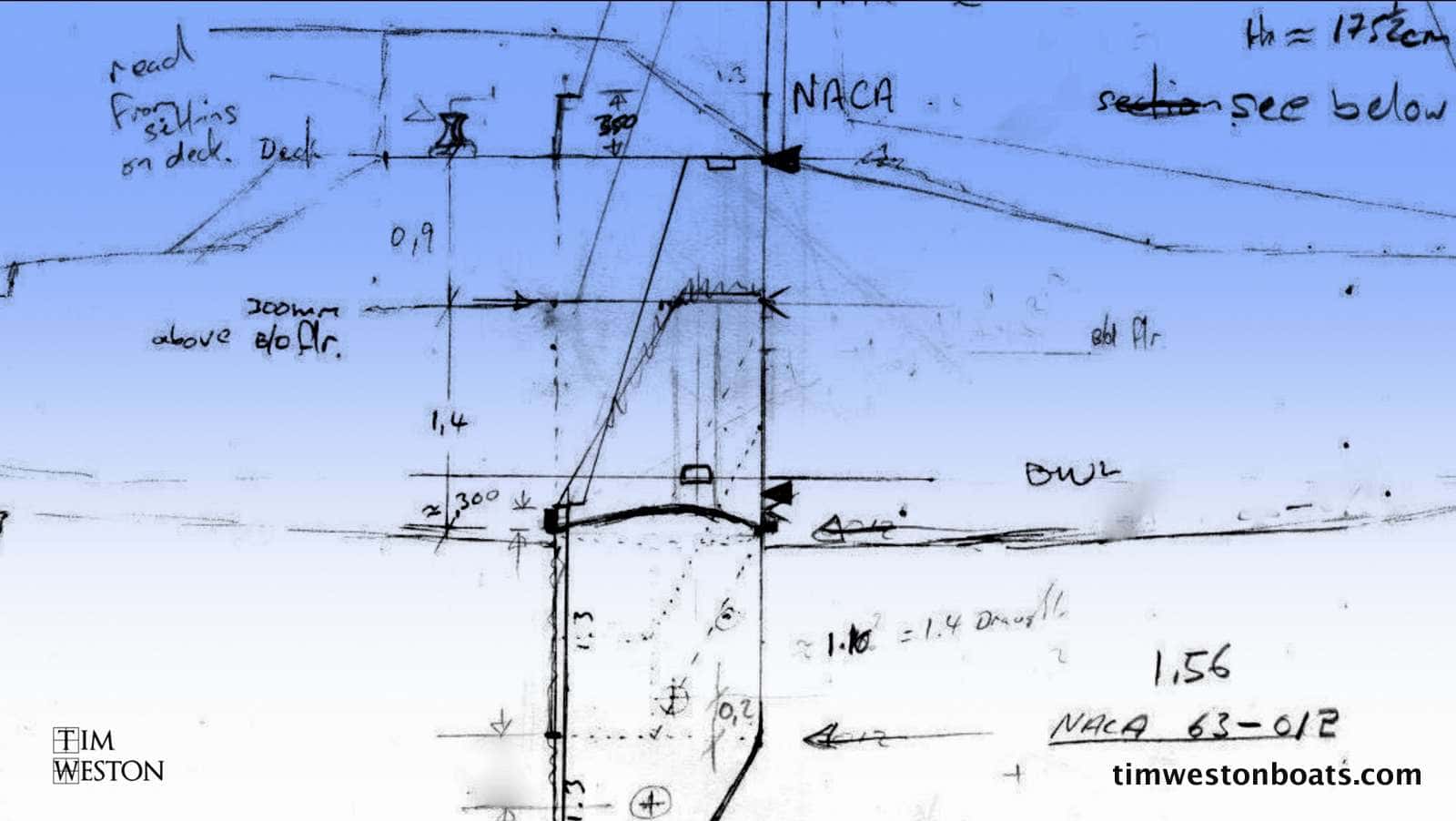
The importance of a daggerboard – in catamaran sailing.
Demystifying the daggerboard. There is nothing mystical about cats that make them inherently poor performers going to wind. In fact, the opposite is true, cats have inherent qualities that make them better than a keel yacht in windward performance. Not leaning over is one of them.
The daggerboard seems to be one of the most misunderstood pieces of equipment on a multihull. Debates on forums and blogs about daggerboards vs mini-keels are many. What are they for? Are two daggerboards better than one? Should you pull them up when going downwind or in a storm? One or both and which side? There seem to be as many opinions are there are blog posts on the subject. They were a mystery to me too when I built my boat, and after a year in the water, I too learned how frustrating it was, going to wind on a cat. I needed to learn more.
Daggerboards and going to wind
I built a 40ft catamaran back in the 90s called “Tokyo Express”. A cruiser/racer that was lightweight and fast downwind and on a reach. But beating to wind was hard work; I covered a lot of ground fast but progress toward my destination was poor.
After a lot of measuring, recording and testing I took all the data I’d gathered and spent months in libraries, going through all the textbooks I could get my hands on, reading up on the hydrodynamics of sailing.
The conclusion I came to was a simple one. Catamarans just don’t have enough keel area. As simple as that. The daggerboards on most cats are way too small. I also believe that their short chords work against them not for them, and mini-keels are, no surprise, worse still.
Cats only seem to get given small daggerboards
Maybe the reasoning designers have for using such small boards (compared to the keel on a similar size monohull), is that because cats are faster, they don’t need as much board area. The trouble is you don’t always move fast, and sometimes speed is the last thing you want. Hauling to wind in heavy weather is one scenario. Once you slow down below the speed, the boards were designed to operate, you have a problem. But even at speed, they don’t point well.
So I left my boat at anchor and spent 3 months in my shed, designing and building a new daggerboard to replace the original ones. One large board instead of two, with 150% more surface area than the original boards put together. I slipped the yacht and installed the new Case and daggerboard, then headed out for my first sail. It was a different boat, totally. It went to wind as I’d never experienced before.
I could now sail as hard to wind as a keel yacht, but faster. I only raced the boat once, in the Whitsundays back in the winter of 1998. It was a fun-race, at the end of a week of racing; most of the boats were racing yachts. Starting on a handicap, 10th last over the start line, behind 130 boats. I headed off on the single lap that we all sailed around, a triangular course with 2 legs hard on the wind and a downwind leg to the finish.
On the first leg, I overtook half of the fleet, sailing as high as, and faster than the racing keel yachts. On the second leg, I passed more boats including all the multihulls, to finish 20th overall behind the large million dollar maxi’s, that started too far in front of me to catch.
The weakest link
The power of the rig depends on the power of the daggerboard that opposes it. If the daggerboard can’t provide the reaction needed, to the sideward forces generated by the sails, then you will not get the most out of your rig. If the board can’t handle the forces of the rig, it will stall or semi-stall, allowing the boat to get pushed sideways.
What I noticed most when this happened, was that the rudders loaded up and the boat was difficult to steer. The high side loads caused my rudders to become difficult to turn, and I eventually burned out the autopilot. The rudders were doing what they weren’t designed to do, go sideways through the water.
So I would ease off the wind, reducing the side-load and picking up speed. With the extra speed, the boards generate more lift and the sideslip would reduce enough for steering to improve. Now I was zooming along, but not going where I wanted to go. You need to move fast to get the boards to work, but the extra speed was a waste of time because I couldn’t point high. In heavy weather, I suffered a less than comfortable ride going back and forwards across the wind, instead of making good velocity towards my destination.
Safe (as well as fast)
These problems vanished after I installed the single daggerboard. I sailed for the next 3 years with the new board; it was the best thing I ever did. It saved my butt in the Pacific, and maybe even our lives, in storms my partner and I encountered on the return trip to Australia from New Caledonia and Vanuatu.
Sailing single-handed with a seasick partner, I could get some sleep at night despite the storms. On the 8 day trip out to Noumea, I made headway going to wind in huge seas comfortably, by reefing down and pulling the boat hard up to the wind, locking the boat to the apparent wind using the autopilot coupled to the wind vane.
This kept the speed down and under control, as there was a big sea running and it was rough. I could point high and make good progress toward my destination with my speed under control. The boat followed the wind shifts, hard on the wind with a steady 7kts. Even under these conditions of extreme wind, and slow boat speed, there was no sideslip. The steering was effortless and the small autopilot I’d since replaced could do the job without problems.
The boat drove like a tractor upwind and I think that is the best analogy I can think of to describe it. I couldn’t imagine being out there in those conditions the way the boat used to sail; hard to steer, half out of control and not going to where I wanted to go.
The daggerboard is the heart of a multihull
You can have the slipperiest of hulls, lightest of boats and most expensive rig, but if you don’t have this part of the boat right, you are not getting good returns on the money spent in the other areas. It doesn’t matter if you are racing or cruising, the ability to go to wind makes or breaks a boat. I have a video about the daggerboard, on youtube.
If you aren’t happy with your cat’s performance and are interested to do something about it, I now have plans available, so you can build a large daggerboard yourself.
Whether you are building a new boat, or you own a cat already, you can replace the original boards with a big one, that will change your boat forever. You won’t recognise your boat afterwards, and as a bonus, you win a lot more room in the hull without the 2 nd board, i.e. freeing up space in the galley. Check out the new webpage for more details and if you would like more information, send me an email .
I hope this has been helpful.
PS — I have a book out now “ Building Tokyo Express ”, with the story of the building of my cat. The next book coming is due early 2020; it’s the story of the 5 years I lived aboard TE and goes into a lot of detail about sailing with this board, and the valuable lessons I learned. Subscribe on the website, and grab the book when it launches at the intro price.
Share this:
- Click to share on Facebook (Opens in new window)
- Click to share on Reddit (Opens in new window)
- Click to share on WhatsApp (Opens in new window)
- Click to share on Pinterest (Opens in new window)
Related Posts
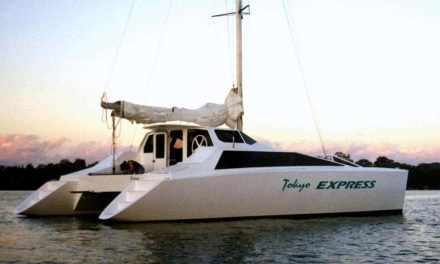
- Catamaran vs Monohull
March 11, 2019
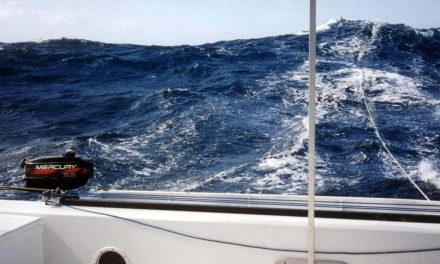
- Catamaran size – how big a boat do you need – ocean sailing
October 18, 2017
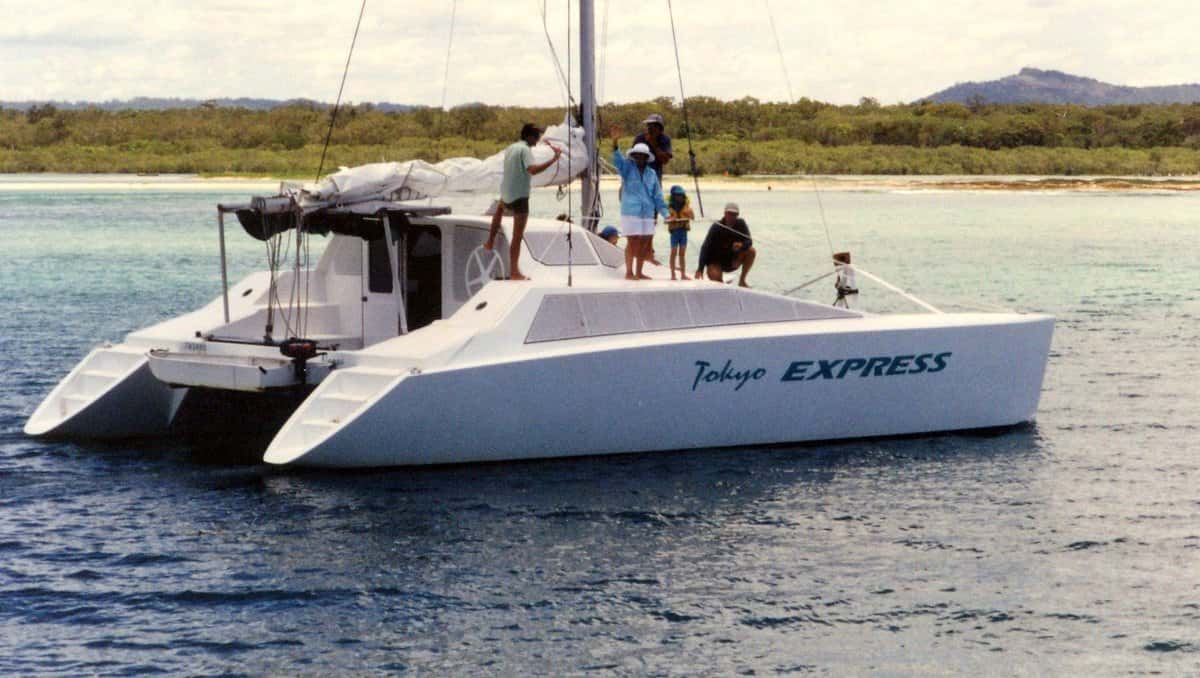
Cruising video is up
August 30, 2016
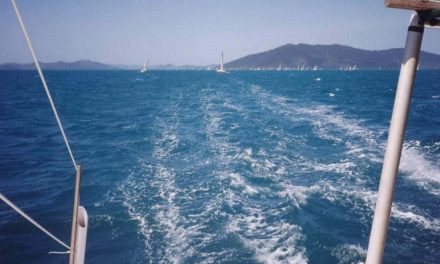
How fast are catamarans
May 23, 2017
Thanks for posting this information!
Very interesting I recently sail A 6 meter beach cat Thanks
I built the UNI-CAT a fun 14 foot x 7 ft boat the solution to dagger boards for that was to use 4 very & narrow short boards that could rotate slightly 2/3 back from the leading when inserted in their slots. In light winds use all 4, but in stronger winds use only 2. They only added 1 foot to the draft but because thet pointed into wind the boat could point to where you were headed without side drift. Later I modified it to use only 1 but controlled the amount of rotation.
What do you think? Leave your comment.. Cancel reply
Search site, new book – just released.
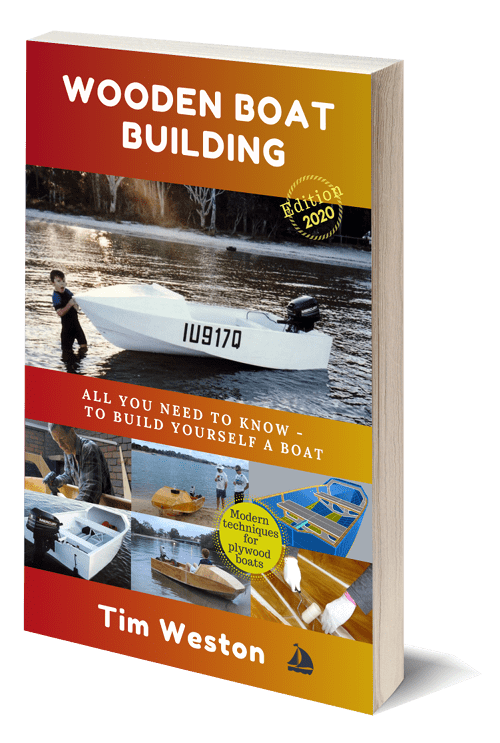
Watch the Video Series – (1 hour & 45 mins)
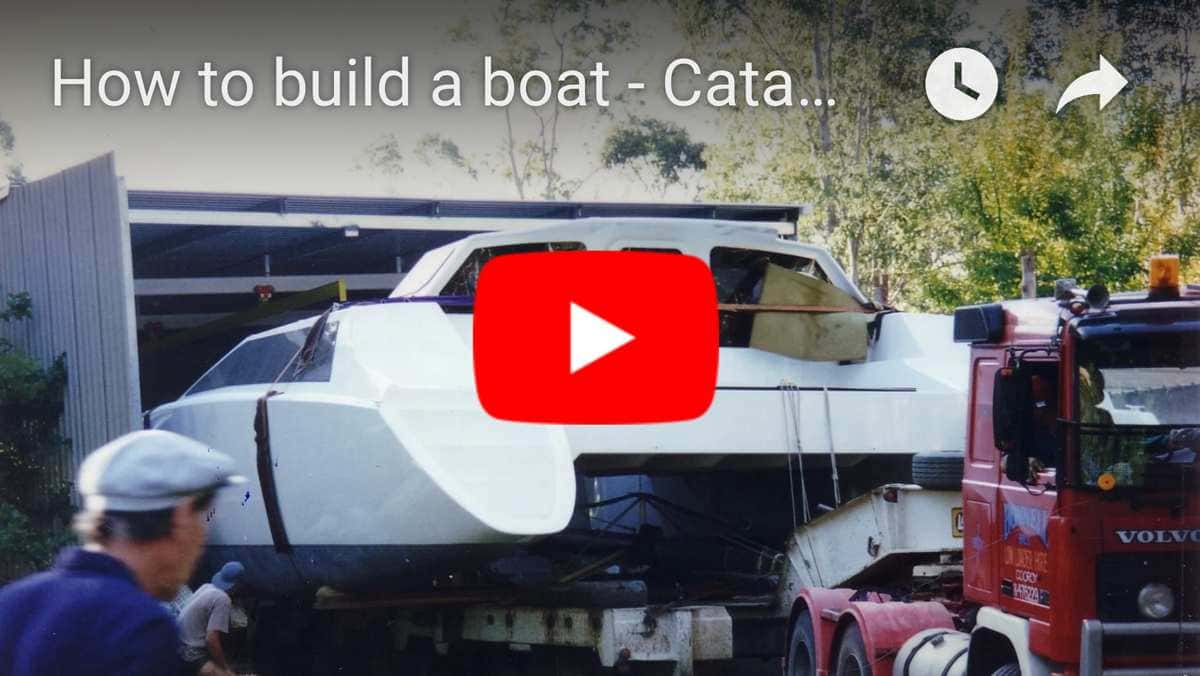
Recent Posts
- Going fast – in small boats – hull speed.
- Keeping safe – while building your boat
- How much does it cost to build a boat – a 40ft Catamaran?
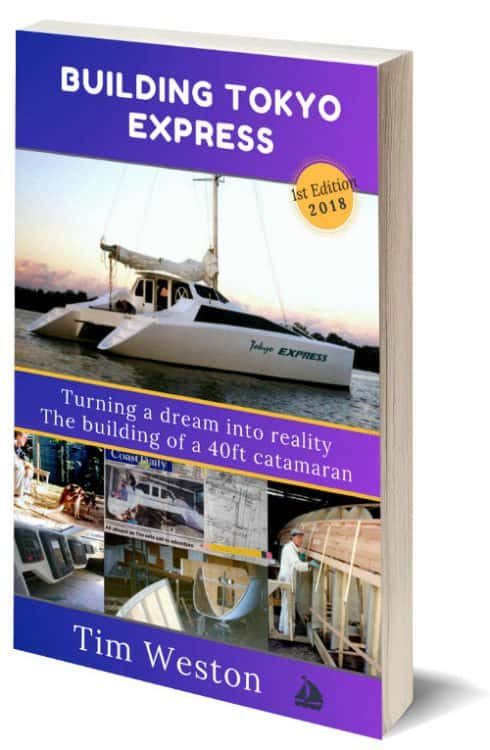
Get the Guide – Free
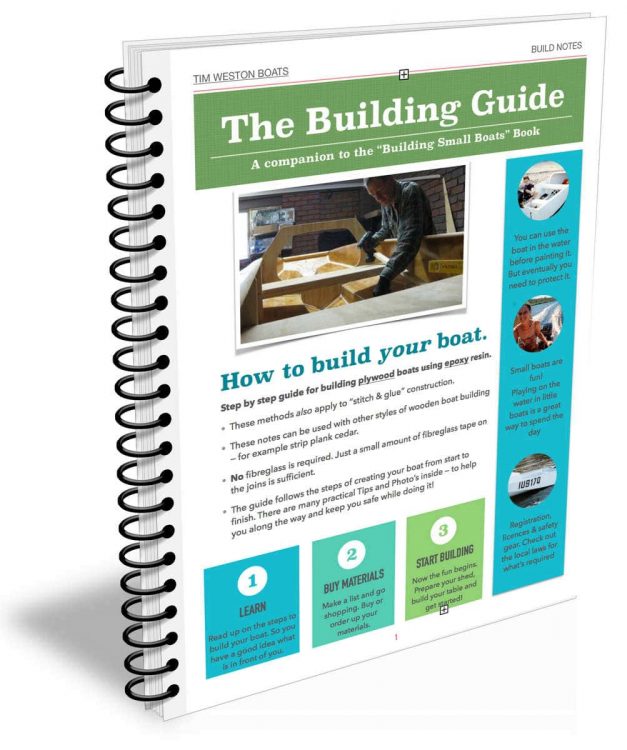
Privacy Overview
Did You Know That We Offer Contract to Closing Services? Click Here to Find Out More.
Need Marine Financing? Apply Here With Our Partner, First Approval Source
- Catamaran Interviews
- Catamaran Reviews
- Buying Advice
- Selling Advice
- Woods Design Advice
- Americat 3014
- Balance 526
- Bali 40 Catspace
- Beneteau Blue II
- Broadblue 346
- Broadblue 38 Prestige
- Broadblue 385
- Broadblue 435
- Broadblue 46
- Catalac 10M
- Catalac 11M
- Catalac 12M
- Catalac 900
- Catana 42 S
- Chris White 48 Voyager
- Chris White 55
- Corsair F28 R
- De Villiers
- Dolphin 460
- Endeavour 30
- Endeavour 35 Victory
- Endeavour 36
- Endeavour 44
- Endeavour 44 TrawlerCat
- Fortuna 36 Island Spirit
- Fortuna 401 Island Spirit
- FP 32 Maldives
- FP 35 Tobago
- FP 37 Antigua
- FP 38 Athena
- FP 39 Fidji
- FP 40 Lavezzi
- FP 40 Lucia
- FP 40 Summerland MY
- FP 41 Lipari
- FP 42 Astrea
- FP 42 Venezia
- FP 43 Belize
- FP 44 Helia
- FP 44 Orana
- FP 46 Bahia
- FP 46 Casamance
- FP 48 Salina
- FP 56 Marquises
- FP 57 Sanya
- FP 60 Eleuthera
- FP Saona 47
- Gemini 3000
- Gemini 3200
- Gemini 3400
- Grainger 420 Mystery Cove
- Hirondelle 7M
- Lagoon 37 TPI
- Lagoon 42 TPI
- Lagoon 43 PC
- Leopard 39 PowerCat
- Leopard 45 Classic
- Leopard 47 PowerCat
- Leopard 51 PowerCat
- Leopard 53 PowerCat
- Maine Cat 30
- Maine Cat 41
- Matrix 450 Vision
- Matrix 760 Silhouette
- Maverick 400
- Maverick 420
- Maverick 440
- Nautitech 40
- Nautitech 442
- Nautitech 46 Open
- Nautitech 47
- Outremer 40
- Outremer 45
- Outremer 50 Standard
- Outremer 55
- Privilege 37
- Privilege 39
- Privilege 42
- Privilege 43
- Privilege 435
- Privilege 45
- Privilege 465
- Privilege 48 Transcat
- Privilege 482
- Privilege Serie 5
- Prout 31 Quest
- Prout 33 Quest
- Prout 34 Event
- Prout 35 Snowgoose
- Prout 37 Snowgoose
- Prout 37 Snowgoose Elite
- Prout 38 Manta
- Prout 39 Escale
- Royal Cape 45
- Royal Cape 530 Majestic
- Royal Cape Majestic 500
- Sailcraft 30 Iroquois
- Sailcraft 32 Comanche
- Sailcraft 35 Cherokee
- Sailcraft 41 Apache
- Sailcraft 44 Apache
- Wildcat 350
- Seawind 1000
- Seawind 1160
- Seawind 1200
- Seawind 1260
- Seawind 1600
- Solaris 36 Sunrise
- Solaris 36 Sunstar
- St Francis 44
- St Francis 48
- St Francis 50
- Stealth 11.8
- Heavenly Twins 26
- Ocean Twins 38
- Voyage 380 Maxim
- Voyage 400 Norseman
- Voyage 430 Norseman
- Voyage 450 Cabriolet
- Voyage 47 Mayotte
- Wharram 38 Tiki
- AMI 320 Renaissance
- Woods 22 Wizard
- Woods 35 Banshee
- Woods 35 Flica
- Woods 36 Scylla
- Woods 36 Vardo
- Woods 38 Transit
- Woods 40 Meander
- Xquisite X5
- Xquisite X5+
Catamaran Daggerboards and Keels – Woods Interview # 9
- Post author By Diane Selkirk
- Post date March 27, 2021
- No Comments on Catamaran Daggerboards and Keels – Woods Interview # 9

I am with Richard Woods, and we are talking about catamarans. He’s a legendary catamaran designer and experienced catamaran sailor of many different designs. This is one of several interviews we’re having on different topics. Today, we’re talking about daggerboards versus keels. Richard will tell us a little bit about how daggerboards work, how keels work, and what some of the benefits of each are.
For more from Richard Woods, please go to his website .
Richard, can you start off with what dagger boards and keels do for a boat?
There’s the three basic ways of preventing leeway, which is what you’re going to be doing with a multihull. On a monohull you’ve got the keel. Essentially, it’s for stability to balance the heeling, to stop the boat heeling too much. You don’t have that as a problem on a multihull. You are just trying to stop leeway.
You can do it either with using the hull shape, which would be like a Catalac or Wharram catamaran. Then the next would be to have keels. The third would be to have daggerboards.

You could essentially say that a catamaran with keels is a bit like a long-keel monohull, and the daggerboard catamaran is a fin keel monohull in more terms. I think we all know and all agree that the best sailing boats are going to be the one with fin keels. Then progressively a long-keel boat or keel or one with low aspect-ratio keels on the catamaran, that would be the next best. Then the one relying just on hull shape, whether it’s a test barge or a Catalac is going to be the the least good.

There’s two things on that. One is that the daggerboard prevents leeway better, but also prevention of or reduction of pitching, increasing potential top speed. You want to have buoyancy at the ends of the boat and not in the middle. You imagine a diamond shape sailing to windward, and it pitches up and down, up and down, and you end up hobby-horsing. Whereas a boat with fuller ends isn’t going to do that. Unfortunately, the thing with their keels, is that the buoyancy is more in the middle of the boat.

So there’s the two factors: one is the the sea kindliness of having daggerboards, and the other is the better performance.
A daggerboarded boat is always better, but it does have some disadvantages. The main one is that if you want to beach your boat or dry it out. To me, that’s always a major advantage of a multihull. You got to be able to have lifting rudders, and essentially, you don’t want your propeller to be the deepest part of the boat, or if you’ve got an inboard engine.
The daggerboarded boats work really well when you’ve got outboard engines and when you’ve got tiller steering, because it makes it easier to get the rudders. It is still possible on bigger boats and you can also have a bit of a compromise of having a small keel, and then the daggerboard. Or you can have like your boat was, which had daggerboards in the lead hull, so you didn’t need to lift the rudders. The rudders are still higher than the bottom of the keel.

Although there’s a lot of places in the world where you don’t have to beach the boat, the most obvious to say: the Great Lakes in North America, Florida, the Bahamas, most of the Caribbean in fact, you don’t have to. The Mediterranean. They don’t have tides and so you’re not in the beach.
I’ll just show you this. I’m just going to turn the camera around a bit now. As you can see, this is our house now. In fact, it’s low water and we have about an 18-foot tidal rise, so that’s more than you. It actually is neat, so it goes up quite a bit further. But we are used to drying out for six hours a day, every day when we moor our boats. So for us, it’s much more important to have good protection for the bottom of the boat.
If you’re sailing in Florida and then you sail up to say, Cape Maine, you suddenly get to the box and you get this 10, 12-foot tide, and you do want to go around, either deliberately or what not. With daggerboarded boats, you’ve got to think about a lot more when you’re beaching a boat.
The interior room, you might think that was a problem. But usually you can make the daggerboard, say, fit around the side of a heads compartment, or the galley worktop, or something like that, so it’s never really a problem. You can have the dagger board on the inside or the outside of the hull, it doesn’t seem to make much of a problem either.

But the other thing is that the daggerboards are more expensive to make because you’ve got to make the daggerboard case, which is in effect, same as making a keel. Then the daggerboard and then the controls for the daggerboard, so that all adds to cost and complication.
And there’s definitely a learning curve to knowing how to use the daggerboard effectively, and have that experience. So are they less of a beginner kind of attribute on a catamaran and more of a somebody who’s been sailing for a while?
Yes. There’s no point really, in having daggerboards if you’re not going to use them. Essentially, that means having them in simplest, both down sailing to windward, and then lift the leeboard when you’re reaching, and lift both when you’re sailing downwind. That’s the normal.
But you can have the position of, if you’re sailing in big seas, especially big quartering sea downwind, the tail wags the dog. In other words, the rudder steers, and it’s not actually doing anything, because there’s no hull in the water. Then, it makes it a lot easier having the daggerboards both half down.

So yes, you learn quite quickly how your boat behaves according to whether the daggerboards are up or down.
The other thing that I found, is that a lot of people, when they break a daggerboard, it tends to be the lead daggerboard that breaks. When you’re sailing, that’s the side that gets powered up when you’re pushing down on being hit by a wave, and pushing sideways tends to break the daggerboard.
Of course the other thing is, it’s quite a good ultimate echo sounder. We have never actually broken a daggerboard, on any boat, I don’t think. When we were, this is a good excuse because it was an unmarked reef, but we were sailing off Nicaragua, and we were sailing at eight knots. We hit a reef with the daggerboard and the boat stopped dead. In fact, my wife fell over. It was driving a car at 10 miles an hour into a wall, sort of effect, and once we sorted ourselves out, and we lifted the daggerboard, we lost about the trailing edge, about a foot by four inches being totally destroyed. We had a mill u-volt, a 5/16th u-volt, as an up haul, and that was bent completely flat by the force of the boat stopping.
I guess it was a sacrificial item!
We still sailed.
Right. That’s what I’m thinking. Rather than hitting the reef with your boat, you hit it with something sacrificial. They can be expensive to replace, but…
Yes. We didn’t hit it with the boat, no. We hit it with something that we could carry on for another three months before we actually had it taken out of the boat and repaired.

Of course, that’s always something. If you can take the broken bit to the mechanic, or to the boat yard, that’s always better than doing it the other way around. Usually, you can carry on sailing with one daggerboard or two half-daggerboards, whatever, but it is quite a common problem.
As I say, if you’ve got a conventional inboard engine with fixed rudders, there are quite a lot of multihulls around, even here, but they’re treated like monohulls. You can’t, for example, go to the Scilly Isles and go to Hawaii, and Green Bay, which is a wonderful place to spend a lifetime, really. It’s the nearest the equivalent of going into the Bahamas. But you can’t do that if you’ve got a boat you can’t dry out.

I guess that’s why multihulls became so much more popular in the UK before other places.
Everything in design, it’s always interconnected. Going back to the comfort, and the rolling. If you look at the Scilly Isles, which are 30 miles off the Southwest corner of England, sort of like saying you’re going out of Miami, and there’s the Bahamas. It’s not quite that far, but it’s pretty near the same as going to Bimini.

There’s a whole stack of islands, but the pilot guide says there is no safe anchorage, because it was written by a monohull sailor. We’ve been and they say, “You know, if you go into this anchorage, then you’re going to be as protected as you can be.” We’ve been into those anchorages, and they’ve been horrible, because you’re open to when the tide’s in. You’re open to the ocean because when they’re out, it’s out in the Atlantic. When you can dry out, you go onto these lovely sandy beaches, and you can dry out and you’re safe then.
Well that’s cool. So thank you Richard, that was fascinating on daggerboards and keels.
- Tags Buying Advice , Richard Woods

By Diane Selkirk
I love to travel and have spent the past seven years sailing with my family aboard our 40 Woods Meander catamaran - traveling from B.C.'s north coast, to the west coast of the US, Mexico, the South Pacific, Australia, New Zealand, South East Asia, across the Indian Ocean to South Africa and on to St Helena, South America, the Caribbean and Central America.
Leave a Reply Cancel reply
Your email address will not be published. Required fields are marked *
Save my name, email, and website in this browser for the next time I comment.
Catamarans with Daggerboards: Enhancing Stability and Performance
by Emma Sullivan | Aug 9, 2023 | Sailboat Lifestyle
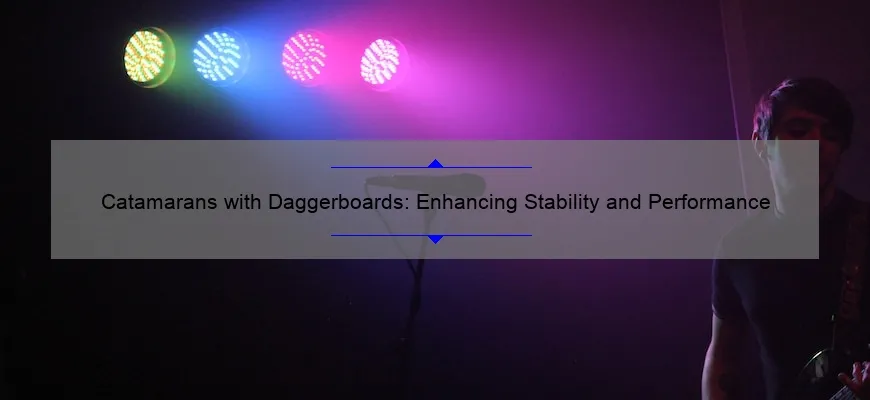
Short answer catamarans with daggerboards:
Catamarans with daggerboards are multihull sailboats consisting of two parallel hulls and vertical foils called daggerboards that can be raised or lowered. Daggerboards improve stability, reduce leeway, and increase upwind performance by minimizing side slipping. These high-performance catamarans are commonly used in racing, offshore cruising, and recreational sailing due to their enhanced speed and maneuverability capabilities.
How Catamarans with Daggerboards Enhance Sailing Performance
If you’re a sailing enthusiast, you may have heard about the growing trend of catamarans equipped with daggerboards. But what exactly are daggerboards and why do they enhance the sailing performance of these unique vessels ? In this blog post, we’ll dive into the details and give you a professional, witty, and clever explanation.
First things first – let’s understand what a catamaran is. A catamaran is a multi-hulled vessel consisting of two parallel hulls connected by a deck structure. Unlike traditional monohulls, catamarans offer increased stability due to their wider beam. This stability means more balance when sailing through choppy waters or in heavy winds . However, even with their inherent stability advantage, there’s always room for improvement when it comes to performance.
This is where daggerboards come into play. Daggerboards are vertically retractable underwater fins that can be found on both sides of a catamaran’s hulls. These boards mimic the functions of centerboards or keels found in monohulls, but with some key differences .
Unlike fixed structures on monohulls, daggerboards can be raised or lowered based on different wind and sea conditions. And trust us – this simple mechanism makes all the difference in terms of performance! By adjusting the depth at which the daggerboard extends below the waterline, sailors can optimize the flow of water around their vessel.
When cruising downwind or in lighter winds, raising the daggerboard allows for shallow draught navigation while minimizing drag created by unnecessary underwater surface area. On the other hand, when sailing upwind or encountering stronger gusts, lowering the boards increases lateral resistance and prevents sideways slippage known as leeway.
Essentially, daggerboards function as hydrofoils for catamarans . They create lift by exploiting Bernoulli’s principle – faster-moving air above generates lower pressure compared to slower-moving air below an object’s surface (or in this case, water). This lift effect counteracts the forces acting on the hulls and reduces slippage, thus improving both speed and control.
But let’s not forget about the clever engineering behind daggerboards. These modern-day marvels are crafted from lightweight yet durable materials such as carbon fiber or fiberglass, ensuring optimum strength-to-weight ratios while keeping performance at its peak. The adjustable nature of daggerboards also comes into play during maneuvers like tacking or gybing, making it easier for sailors to change direction smoothly without losing precious momentum.
So why should you care about catamarans with daggerboards? Simple – they offer a thrilling sailing experience with enhanced performance capabilities. Whether you’re seeking the adrenaline rush of competitive racing or just looking for a smooth cruise across open waters, these vessels provide unbeatable stability and speed that can take your sailing game to new heights.
In conclusion, catamarans equipped with daggerboards have revolutionized the world of sailing by maximizing performance through clever hydrodynamics and adjustability. So if you’re ready to enhance your sailing adventures with a touch of finesse and innovation, hop aboard a catamaran with daggerboards and prepare to ride the waves like never before!

Exploring the Benefits of Catamarans with Daggerboards Step by Step
Title: Exploring the Benefits of Catamarans with Daggerboards Step by Step
Introduction: Catamarans have gained widespread popularity in recent years due to their stability, speed, and spaciousness. One key element that maximizes the performance of catamarans is the presence of daggerboards . In this blog post, we will delve into the benefits of catamarans equipped with daggerboards, exploring each step involved. From improved sailing capabilities to enhanced comfort , let’s discover the remarkable advantages these sleek vessels offer.
Step 1: Understanding Daggerboards in Catamarans Daggerboards are vertically retractable appendages mounted on both hulls of a catamaran. Serving as underwater wings, they can be lowered or raised depending on sailing conditions. When deployed, daggerboards greatly contribute to a sailboat ‘s lateral resistance and stability.
Step 2: Heightened Stability at Sea One prominent advantage of catamarans with daggerboards lies in their exceptional stability. The wide beam between two hulls minimizes rolling motion even under rough sea conditions, offering an incomparable sense of security for those prone to seasickness or seeking a more comfortable cruising experience.
Step 3: Superior Upwind Performance Daggerboards revolutionize a catamaran’s ability to sail upwind effectively. By lowering both daggerboards symmetrically, the wetted surface area decreases, reducing drag significantly while maintaining lateral resistance. This enables catamarans with daggerboards to venture closer to windward than traditional keel-powered boats – an invaluable feature for sailors navigating challenging coastal or offshore routes.
Step 4: Enhancing Maneuverability When maneuvering close to shorelines or marinas, daggerboards provide heightened control and agility. Their adjustable nature allows sailors to alter their angle or completely retract them into the hulls when additional clearance is required – ensuring simple navigation through shallow waters or tight spaces where other vessels may struggle.
Step 5: Increased Speed Potential The presence of daggerboards in catamarans grants them superior speed capabilities, especially in reaching conditions. With reduced drag and improved stability, these formidable vessels can easily harness the power of the wind, gliding swiftly across open waters . Daggerboards enable a catamaran to maintain higher average speeds throughout long passages, ensuring quicker and more enjoyable journeys.
Step 6: Enhanced Safety Catamarans equipped with daggerboards boast enhanced safety features that make them an ideal choice for offshore cruising or adventurous sailing trips. By allowing sailors to control their draft depending on the sea state or desired performance, daggerboards minimize the risk of grounding or collisions with underwater hazards. This versatility enhances overall onboard safety and peace of mind.
Conclusion: Daggerboards are not merely another feature found in high-performance sailing vessels; rather, they revolutionize the way catamarans navigate through various conditions. From heightened stability at sea to improved maneuverability and increased speed potential, these retractable appendages offer unparalleled benefits for enthusiasts seeking comfort, agility, and thrilling experiences on the water . Next time you embark on a catamaran adventure, keep an eye out for those sleek daggerboards that make every voyage a remarkable one!
Frequently Asked Questions about Catamarans with Daggerboards
Are you considering purchasing a catamaran with daggerboards but find yourself overwhelmed with questions? Fear not! We have compiled a comprehensive list of frequently asked questions about catamarans equipped with daggerboards to quench your curiosity. From the advantages they offer to common misconceptions, we’ve got you covered. Join us as we delve into this intriguing topic.
1. What is a catamaran with daggerboards?
A catamaran with daggerboards is a type of sailing vessel that features two hulls connected by a platform known as the bridge deck. Unlike traditional catamarans, these innovative vessels are equipped with retractable keels called daggerboards which can be adjusted based on sailing conditions.
2. Why choose a catamaran with daggerboards over other designs?
Catamarans with daggerboards offer numerous advantages for avid sailors. Firstly, their ability to retract or extend the boards allows for enhanced maneuverability and increased speed in different weather conditions . This means greater control when sailing upwind or in shallow waters where other boat types might struggle.
3. How do daggerboards affect performance?
Daggerboards significantly improve sailing performance by reducing sideways drift (known as leeway) and increasing the lateral resistance provided by the keels. By adjusting their position according to wind direction, sailors can optimize their boat’s angle against prevailing forces and achieve higher speeds.
4. Do I need any special skills to handle a catamaran with daggerboards?
While operating any sailboat requires some level of skill and experience, handling a catamaran with daggerboards doesn’t demand extraordinary expertise. As long as you possess basic sailing knowledge and understand how to utilize the adjustable keels effectively, you’ll be able to harness the full potential of these vessels easily.
5. Are there any drawbacks to using daggerboards?
Although the advantages of using daggerboards significantly outweigh potential downsides, there are some considerations worth mentioning. Catamarans equipped with daggerboards may have a higher initial cost compared to other designs due to their specialized construction. Additionally, maintenance and repairs for the daggerboard mechanisms might require more attention.
6. Can I still sail a catamaran with daggerboards in shallow waters?
Absolutely! The retractable nature of daggerboards enables catamarans to navigate shallow waters with ease. By lifting the boards, you can safely venture into areas where conventional keels would prohibit passage, opening up new possibilities for exploration while maintaining stability.
7. Are catamarans with daggerboards faster than those without?
The adjustable nature of daggerboards does provide potential for increased speed, particularly when sailing close to the wind or upwind . The reduced drag caused by retracted boards allows these vessels to efficiently glide through the water, resulting in impressive acceleration and velocity that can outperform traditional catamarans.
8. Are there any misconceptions surrounding catamarans with daggerboards?
Indeed, a common misconception is that daggerboards are solely beneficial for racing purposes or experienced sailors seeking high-performance vessels . However, these boats are equally suitable for cruising enthusiasts looking to enjoy enhanced control, stability, and overall comfort during their nautical adventures.
In conclusion, choosing a catamaran with retractable daggerboards offers an innovative approach to sailing characterized by improved performance and adaptability across various conditions. Novice or seasoned sailors alike can make the most of these unique vessels while exploring shallow waters or harnessing greater speed capabilities. So set sail confidently on your next maritime adventure armed with knowledge about these fascinating catamarans!
Understanding the Mechanics Behind Catamarans with Daggerboards
When it comes to sailing, catamarans have gained considerable popularity due to their stability and speed. But what sets these sleek vessels apart from traditional monohull sailboats ? The answer lies in their unique design, particularly the incorporation of daggerboards. In this blog post, we will dive deep into understanding the mechanics behind catamarans with daggerboards, shedding light on why they are favored by sailors all over the world.
To begin with, let’s familiarize ourselves with the fundamental concept of a catamaran. Unlike monohulls that have a single hull cutting through the water, catamarans boast two parallel hulls connected by a platform or bridge called the trampoline. This setup enhances stability and prevents excessive rolling, making them an excellent choice for those looking for a smooth and comfortable sailing experience.
However, it is worth noting that stability alone does not guarantee optimal performance . That’s where daggerboards come into play. These vertically oriented keels perform multiple functions that elevate a catamaran ‘s capabilities and maneuverability.
Firstly, let’s understand what exactly a daggerboard is. A daggerboard is essentially a retractable keel located within each hull of a catamaran. These boards are designed to slide up and down vertically through special slots or cases known as trunkings in order to adjust their depth beneath the waterline.
One of the primary roles of daggerboards is to counteract leeway – the sideways movement experienced by boats when subjected to wind pressure against their sails . By adjusting the depth of daggerboards on either side independently, sailors can effectively control leeway and sail closer to the wind without significant drifting off course.
In addition to countering leeway, these clever appendages also enhance upwind performance—a crucial aspect for competitive racing or efficient long-distance sailing . When fully deployed, daggerboards create additional lift as water flows over them at high speeds . This lift opposes the sideways force acting on the boat from the wind, allowing the catamaran to maintain a more efficient angle into the wind and achieve higher speeds.
Furthermore, daggerboards play a crucial role in preventing capsizing – an occasional nightmare for sailors. By adjusting the depth of daggerboards when facing strong gusts or turbulent sea conditions, sailors can maintain balance and stability, reducing the risk of flipping over.
It’s important to note that daggerboards are highly adjustable and require skillful handling by experienced sailors. Proper adjustment involves considering various factors like wind speed, boat speed, sea state , and desired sailing objectives. Fine-tuning these elements allows sailors to optimize performance in different conditions while keeping safety in mind.
While some catamarans utilize fixed keels or even foils instead of daggerboards, traditional daggerboard designs continue to dominate due to their simplicity, reliability, and cost-effectiveness. They offer versatility across a range of sailing styles from leisure cruising to competitive racing.
In conclusion, understanding the mechanics behind catamarans with daggerboards is essential for anyone looking to venture into this sailing realm. From countering leeway and optimizing upwind performance to enhancing stability and preventing capsizing; these retractable keels serve as invaluable tools in ensuring a safe yet exhilarating experience on the water. So next time you see a catamaran gliding effortlessly through waves with precision-like control, you’ll have an appreciation for the intricate role played by its trusty daggerboards.
Why Choosing a Catamaran with Daggerboards Can Revolutionize your Sailing Experience
Choosing a catamaran with daggerboards can completely revolutionize your sailing experience, taking it to new heights of performance and excitement. These sleek and innovative designs offer numerous advantages that will leave you wondering why you ever sailed on a traditional monohull.
Firstly, let’s talk about speed. Catamarans with daggerboards are known for their incredible acceleration and high top speeds. The combination of the streamlined hulls and adjustable daggerboards allows these vessels to slice through the water effortlessly, leaving monohulls in their wake. Imagine the thrill of gliding across the waves at exhilarating speeds, feeling the power of the wind pushing you forward – an experience that will make you truly feel alive.
But it’s not just about speed; catamarans with daggerboards also excel in upwind sailing. Due to their narrow beam and powerful sail plan, these boats can efficiently navigate against the wind , tacking smoothly without losing momentum. With each tack, you’ll notice how effortlessly the daggerboards optimize your angle towards the wind, giving you an advantage over other sailors struggling to maintain course.
One of the most significant advantages of catamarans with daggerboards is their ability to sail in shallow waters. By retracting the daggerboards partially or fully, depending on conditions, these boats can access secluded beaches, anchor closer to shorelines, or explore hidden coves inaccessible to larger vessels. The flexibility and freedom they provide allow for endless possibilities when it comes to island hopping or discovering remote destinations.
In terms of stability, nothing compares to a catamaran with daggerboards. Unlike monohulls that heel dramatically while sailing at high speeds or encountering rough seas, these two-hulled beauties remain steady as a rock thanks to their wide stance and deep-draft daggerboards. You’ll appreciate this stability when cooking onboard during passage or simply enjoying a relaxing day out on calm waters without being constantly tossed around by waves.
Furthermore, catamarans with daggerboards offer a spacious and comfortable living area. With their open, airy layouts, these vessels provide ample room for entertaining guests or accommodating a large group of family and friends on extended voyages. The absence of heeling also means there’s no longer any need to adjust your lifestyle to counteract the boat’s movement, allowing you to live onboard with ease and comfort.
Finally, catamarans with daggerboards are often praised for their low fuel consumption. Due to their lightweight construction and reduced drag caused by the daggerboards, these boats require less power to propel them through the water compared to traditional monohulls. This not only saves money but also serves as a step towards environmentally conscious sailing .
In conclusion, choosing a catamaran with daggerboards will undoubtedly revolutionize your sailing experience. From the exhilarating speed and upwind performance to the ability to navigate shallow waters effortlessly, this innovative design offers unmatched advantages that will enhance every aspect of your time on the water. Get ready to embark on an unforgettable adventure where excitement meets comfort and where possibilities become truly limitless!
Tips and Tricks for Maintaining and Caring for Catamarans with Daggerboards
Title: Mastering the Art of Catamaran Care: Unleashing the Potential of Daggerboards
Introduction: Ah, catamarans! The epitome of grace and freedom on water. These magnificent vessels offer a unique sailing experience, especially if equipped with daggerboards. These retractable appendages not only enhance performance but also require special attention when it comes to maintenance and care. Today, we are here to unveil our arsenal of professional, witty, and clever tips and tricks for maintaining and caring for catamarans with daggerboards.
1. Raise Your Daggerboard Awareness: To truly understand your catamaran ‘s daggerboards, it is crucial to comprehend their purpose and functionality. Daggerboards act as underwater foils that counteract lateral forces, providing stability and control while sailing. Take time to study their design, engage in valuable online discussions or seek guidance from experienced sailors.
2. Regular Inspection is Key: Just like any other component on your vessel, regular inspection of your daggerboards is essential. Check for wear and tear, potential damage or cracks in the boards themselves or within their housing compartments. Be thorough during inspections to nip any issues in the bud before they snowball into costly repairs or replacements.
3. Smooth Operators: Lubrication Matters! Smoothly operating daggerboards directly impact your sailing experience; squeaky boards are no one’s favorite soundtrack out at sea! Regularly lubricate the sliding mechanisms using suitable marine-grade lubricants – avoiding excessive amounts that could attract dirt or grime – ensuring silent sailing moments that will make you look like a seasoned pro.
4. The Battle Against Corrosion: Saltwater can be both a catamaran’s best friend and sworn enemy simultaneously—the latter being particularly true for metals prone to corrosion. Apply protective coatings or paints specifically designed for underwater use onto metallic portions exposed to oceanic elements surrounding your daggerboard system.
5. Float Like a Feather: Balancing Act: Balance is the key to successful catamaran navigation . Daggerboards play a significant role in maintaining equilibrium while underway. Monitor their vertical alignment carefully, ensuring they are both correctly deployed and fully retracted when needed. Avoid compromising performance by avoiding conditions that push the limits of your daggerboard’s deployment range.
6. Cleanliness above All: Just as your daggerboards slice through the water realm, they can also gather unwanted hitchhikers along the way. Regularly clean their surfaces to eliminate marine organisms, barnacles, or algae that, if left unchecked, can affect hydrodynamics and impose unnecessary drag on your vessel’s overall performance.
7. Seek Professional Guidance: When in doubt or dealing with a problem you cannot confidently resolve yourself – never hesitate to seek professional help! Experienced boat builders or naval architects can provide invaluable advice tailored specifically to your catamaran and its daggerboard configuration.
Conclusion: Catamarans equipped with daggerboards offer an exceptional sailing experience that deserves meticulous care and attention. By following these professional, witty, and clever tips for maintaining and caring for such vessels, you’ll ensure smooth operations and prolong the lifespan of your beloved catamaran with ease. So set sail confidently into endless horizons as you master the art of catamaran care – unleashing the full potential of those marvelous daggerboards!
Recent Posts

- Sailboat Gear and Equipment
- Sailboat Lifestyle
- Sailboat Maintenance
- Sailboat Racing
- Sailboat Tips and Tricks
- Sailboat Types
- Sailing Adventures
- Sailing Destinations
- Sailing Safety
- Sailing Techniques
production Strider 24
plywood Romany 34
lightweight 14ft Zeta mainhull
Strike 15 trimaran at speed
28ft Skoota in British Columbia
10ft 2 sheet ply Duo dinghy
24ft Strider sailing fast
36ft Mirage open deck catamaran
- All Our Designs
- For new visitors
- About Richard Woods
- Useful Articles
- Testimonials
- Plan Updates
- Links to Owners and Suppliers
- Consultancy Service
- Boats for Sale
- Blog and Facebook Posts
- Our Cruising Blog (updated Jan 26th 2020)
- Download Eclipse logbook (300 page pdf)
- Download Newsletters 1992-2002 (pdf)
- Download Year Reviews 2002-14 (pdf)
- Download FAQs (pdf)
- Download Boat Tests (pdf)
Keels or Daggerboards, the pros and cons
When writing about foils (ie boards, keels and rudders) it is easy to baffle people by talking about lift to drag ratios, NACA sections, end plates, twist, stall, Karman vortices and all the rest. So I won't - it's probably best to leave all that to designers and hydrodynamacists Instead I'll try to help those who want to know the basics; like should they have keels or boards on their multihull?
I'm not just a multihull designer; I'm also a (home) boatbuilder and owner. Currently I own two catamarans, one with daggerboards and one with keels. Over the last 30 years I have owned five cruising catamarans with keels, nine with daggerboards and one with one centerboard. Furthermore, I am one of the few designers who has fitted LAR keels and boards to the same hull (on Strider, Sagitta and Banshee) and then sailed them against each other.
As with everything to do with yacht design, leeway prevention is a complex subject. And it is not helped by the fact that boats are not just for sailing. You load them down and treat them as a floating cottage when you live aboard them. You motor them, you dry them out (either when the tide goes out or when stored ashore in a boatyard). And you have to pay for it all.
===========================
First a bit of simple theory
The main factor determining the efficiency of a foil is its "Aspect Ratio" (AR) or the ratio of it's depth to width. I think we all know that a high aspect ratio foil is more "efficient" than one with a low aspect ratio. A 3:1 AR is generally considered ideal for rigs but is usually too high for foils. In fact a 1:1 AR is OK for keels, although 2:1 or a bit more is better. In other words, a 1.5m deep daggerboard on a 10m boat will be about 750mm fore/aft (or more properly called it's "chord"). And it will be about 75mm thick, as the thickness of a foil should be about 8-10% of the chord.
Despite the fact that high AR foils are more efficient, there are a couple of reasons for limiting AR. As the AR increases the chord decreases and so the foil becomes thinner and clearly it is then also weaker. Unfortunately the foil loads have gone up (because the deeper the foil the further the Centre of Lateral Resistance (CLR) is from the bottom of the hull, so the lever has lengthened). So long, narrow foils are more prone to damage (one reason all those monohull keels have snapped off - a J800 lost one just recently).
In addition, the higher the AR the easier it is to stall the foil. When a foil stalls it stops "working", this is most obvious after tacking in a sloppy sea and you find that the boat won't sail properly for a couple of boat lengths. That is because the foil has stalled. In other words, you have to be sailing in flat water and be a very attentive helmsman to avoid stalling a high AR foil.
The lower the AR the bigger the foils area has to be to compensate for the reduced efficiency, however a lower AR is more tolerant of shape, surface roughness and angle of attack (which basically makes it easier to sail)
So how big should a foil be? Roughly 4% of the sail area is a good starting point. Some designers use very small boards. That may be OK in theory, which says that you sail in flat water at maximum speed, but in practice I find you need a bigger board to cope with waves and slow sailing, never mind tacking in a lumpy sea.
Whilst on the dangers of too much theory. Many race boats use sophisticated shapes and low drag sections. Don't use them unless, like top racing boats, you also dry sail your boat. Only the simplest shapes work with a rough surface (even new, clean antifouling is considered rough), these fancy shapes need a smooth, ie a mirror finish, to be of benefit.
I definitely don't like asymmetric foils. True they may give a bit more lift but only one can be used at a time, the other HAS to be raised. So you are carrying around the extra weight of a second board and box plus wasting time adjusting boards after each tack which all makes it not worth the very small efficiency gain.
Many people, especially cruisers, don't mind compromising on performance if it means an easier life, more load carrying and greater protection for the rudders and propellers. And that is why Low Aspect Ratio (LAR) keels are so popular. In much the same way as monohull sailors buy a long keel boat rather than one with a fin keel.
Unfortunately, using LAR keels results in a slower boat and more pitching. That is because to optimize speed you need a hull with buoyancy in the ends, not in the middle (technically you need a high Prismatic Coefficient - Cp). Clearly adding a LAR keel adds buoyancy in exactly the wrong place. Furthermore the midships buoyancy makes the boat pitch more as the hull is more "diamond-like". Having said that the buoyancy in the keel adds to total displacement, so you can carry more gear. And you can use the keel as a water tank/shower sump or even somewhere to fit an engine.
As I have just said, a lower AR means having a bigger foil and so clearly a LAR keel has to have much more area than a daggerboard. Thus the wetted surface area (WSA) is significantly increased, especially when sailing offwind compared to a daggerboarded boat with raised boards. And WSA is the prime source of drag at low speeds. So most designers draw a compromise keel which is smaller than strictly needed to balance the sail forces. But these forces must still balance and this can only be done by having a wider sheeting angle. Which in turn means a LAR boat cannot point as high as one with daggerboards.
So all in all boats with LAR keels are slower on all points of sail and in all conditions when compared to a daggerboarded boat. Say 5deg more leeway and 2deg less pointing. Remember it is hard to tell ones real leeway from looking back at the wake as in a seaway the top 2-3ft of water is blown sideways by the wind. So unless the keel is in deep still water you don't notice that you are drifting sideways until you look at the gps.
Further Design Considerations
Boards can be daggerboards (ie adjusted vertically) or centerboards (ie adjusted by rotating). Even though centre boards sometimes fit better into the accommodation layout and can pivot aft without damage when hitting the ground, daggerboards have proven far more popular. Probably because the centerboard pivot bolt often leaks, while it is very difficult to stop the water surging in the case with the board down, and it is easier for "Stuff" to get stuck in the gap between slot and board, thus jamming the board. A centerboard box/centerboard is probably heavier than using daggerboards. And finally it is harder to remove a centerboard for painting/maintenance.
Angled boards actually take up little interior room and can always be incorporated into accommodation dividers - the nav table bulkhead on a Banshee, the hanging locker on a Sagitta, against the hull side on a Merlin for example. More important is that they then don't bang around in a sloppy sea. Providing the board is angled at under 15deg to the vertical I haven't found any disadvantage in using angled boards. Nor have I noticed any difference between boards placed on the inside of the hull and those on the outside. Certainly there is no advantage in having vertical boards fitted on the hull centerline.
Don't use central boards though the bridgedeck. They simply don't work well. The Prout brothers discovered that in 1953 when they fitted a central board on the prototype Shearwater. By 1954 they had fitted boards in the hulls. The Stiletto catamaran started with a central daggerboard but owners quickly found that converting to ones in the hulls improved performance significantly.
The bottom of a LAR keel should be horizontal, otherwise you'll dry out at angle (OK I know that in many areas boats never dry out, but you want your boat level when in a boatyard) Even worse is a keel that is too short as then the boat can fall forward or aft when people move to bow/stern. Clearly dangerous and damaging to crew and boat.
Building Considerations
Boards are heavy, and more expensive than LAR keels, there's nothing one can do about that. To save weight you can make a short board, so that when down the top of the board is below deck level. Daggerboards can be profiled over their full length. But in that case you need to make the board first, and then make the box round the board. So you need to make expensive boards early on during the build.
The alternative is to profile only the below water portion, leaving the rest rectangular. This means the box is also rectangular, so the board can be made after the box. True, there is some extra turbulence when the board is half raised, but you can negate much of that by fitting a profiled cover plate on the outer side. Also I've found that there are less chance of leaks with a rectangular box and more important, weed, twigs etc are less likely to get between board and case and jam the board.
Many people suggest building a "crash box" to absorb any grounding shock. But be warned! I made one once years ago as an experiment on a dinghy. I ran aground and the board moved back into the crash box, exactly as planned. But then jammed - not part of the plan!! I had to capsize to free the board so I could raise it. Hardly practical on a cruising catamaran!
I haven't used a crash box since, relying instead on a very heavy laminate at the back of the box. My reasoning is that the tapered trailing edge of a board is far weaker than the box and so will always fail first. I proved that when hitting an unmarked reef off Nicaragua and we lost about 300mm x 100 mm of board, yet the box itself was undamaged.
Boards are generally made in timber or foam/glass. I prefer plywood over laminated timber as it is easier to profile. Foam boards are attractive in theory, but it is very hard to stop them warping and getting the correct shape without making a mould first is almost impossible. If you do make a mould you have to join the two halves, and remember boards don't just bend they also twist.
If you can, fit LAR keels as late as possible, this keeps the boat nearer the ground during building and saves a lot of ladder climbing.
What about in use?
Unlike boards, LAR keels are very much fit and forget. So there isn't much to say about keels, except to make sure you have a good sacrificial beaching strip and keep it maintained.
It is sensible to lift the lee daggerboard when reaching, as I have found that most breakages are of the lee board as it gets very loaded at speed. However lifting both boards in a big cross sea is not a good idea as that loads the rudders and that, apart from anything else, makes it heavier to steer, so have both boards half down.
Not being able to lift the lee board for half the time is one reason why I don't like using only one board in one hull. Doing so also means the board is much bigger so there are more local loads and of course it is harder to adjust. And it doesn't seem right to have the CLR so far offline. However if you do fit one board don't fit it in the galley hull as that is always heavier than the other hull.
Lifting the lee board to allow the boat to slip sideways is commonly thought a good idea. I'm not convinced. Tank test work has shown that having a deep lee hull actually helps prevent capsizing. That is because the windward hull lifts to a breaking sea, the sea goes under the bridgedeck and hits the lee hull. Because it is deep it is pushed sideways, which dissipates any overturning energy.
People often think you need a long keel (monohull or multihull) to steer straight "hands off". That simply isn't true. Good directional stability depends on the hull balance. A properly designed daggerboarded boat will sail as straight as a LAR keel one, and have the additional benefit of being quicker to tack and maneuver when necessary.
Finally, if you run aground, you can lift the boards to get off, but remain stuck with keels.
If you don't ever expect to race then keels are OK
If you think crosscut Dacron sails are good enough then keels are OK
If you trail your boat regularly fit dagger boards
If you have wheel steering and inboard engines and expect to dry out often fit keels
If you want the best performance then fit dagger boards, but be prepared to use them

Centerboard VS Daggerboard The Differences Explained
As an Amazon Associate, we earn from qualifying purchases. We may also earn commissions if you purchase products from other retailers after clicking on a link from our site.
Sailing life entails many words that at first make no sense; in this article, I will explain the difference between two types of underwater foils, centerboards and daggerboards.
On a sailboat, the difference between a daggerboard and a centerboard is how they are moved into position. A daggerboard is lifted and raised vertically (up and down) through a slot in the hull; a centerboard, on the other hand, pivots or swings into place.
That was the short answer. There are many more commonalities and differences worth discussing, such as the differences in performance and what happens if your daggerboard hits a reef? Will it break your hull?
Keep reading to understand all you need to know about daggerboards and centerboards!
Table of Contents
Centerboard
The centerboard is mounted horizontally on a rotating bolt at the foremost part of the foil (keep reading to understand what a foil is). It folds into a comparatively much longer slot in the hull than a daggerboard.
A centerboard comes in many different shapes and sizes, it can be combined with an already existing keel, or it can be larger and be more of a stand-alone type.
How is a centerboard operated?
The centerboard is operated through a lifting line fastened at the end of the centerboard fin(board); this line is manipulated either by hand or by a winch and, once fully retracted, will be tied to a cleat.
Daggerboard
The daggerboard, on the other hand, is mounted vertically inside a sliding slot in the hull, it gets it name from the movement, much like the stabbing motion of a dagger.
The board is stopped from moving too far and falling out because the top part is wider than the lower part.
How is a daggerboard operated?
It is manipulated much like the centerboard, through a lifting line and a winch. But instead of being attached through a bolt and swung into position, it is lowered down into place.
What are the differences?
Performance.
Since the differences mainly lie in the way of deployment, there are not that many big difference, but some smaller once worth noticing are;
The daggerboard doesnt have to be either fully up or fully down; this means the sailor can adjust the depth and effects to his or her needs. To low and there will be unnecessary drag, to high and there will be too little lift and too much drift to windward.
On the other hand, the centerboard pivots into position and is only really efficient as a foil once fully deployed.
Reducing the draft of a boat is very important if you want to sail in very shallow waters such as the Bahamas or if you want to beach your cat.
What is beaching a cat?
Once retracted, there is also a decreased chance of getting stuck or tangled up in a fishing net or other semi-floating objects and sometimes hard to see.
On boats where the keel is the lowest point on the boat, the propeller will be protected, but on ships where the center or daggerboard is the lowest spot, then retracting it will make it vulnerable to damage from whales, fishing nets, or coral. You will also not be able to beach your cat since the weight of the ship will be loaded on top of your prop shaft and most certainly will break it.
Once the boards are in a fully lifted position, there is an argument to be made that the centerboard, which has a much larger slot, will have higher drag. This is true, but only if the slot is poorly design and not hydrodynamically smooth, causing underwater turbulence.
A well-designed centerboard should be able to reduce the amount of drag to the same as a daggerboard.
What are the similarities?
Both systems can be mounted in pairs and at an angle; this makes the boards work much as an airplane wing does. Once the water starts passing around it, it will create higher water speeds on the upper side, lowering the pressure and increasing lift.
This makes for less underwater surface, decreases drag, increases speed, and fuel efficiency.
One issue often discussed on forums and with boat people is that a centerboard is safer since if an underwater object hits it, it will fold back into its slot, and no damage will be done. This is true to a degree but worthy of some explanation.
Firstly this is mainly a theoretical argument since an object is not certain to hit the board from straight on; this means that the idea of folding is no longer possible. The next thing to understand is that daggerboards are made to break; this is a safety aspect and makes sure that the hulls stay intact and that the boat will stay afloat.
This is similar to modern mini keels on catamarans; they too are constructed to detach if hit hard enough, the keels fall off, but the hull stays intact.
Both systems offer a risk of getting stuck; some say this is a bigger issue with daggerboards, and they more often fail than the centerboard style. This is not something that I have been able to confirm through any data, and looking at the design of newer daggerboards; there is no real reason to think that this should be the case.
There are many different systems on a sailboat, and everything that can move will sooner or later stop moving due to rust or being filled up with salt and sand. So will too these boards; this means extra time for maintenance and extra money to be spent keeping the systems in good shape.
Compared to each other many would argue that the centerboard is a somewhat simpler system and that they need less maintenance; I would say it is more up to the specific design than whether or not it is a centerboard.
Catamarans and Monohulls
The basic function of a foil is the same whether you’re on a catamaran or a monohull, although some aspect is specific for a cat.
A catamaran will always have two boards; these can be used together or separately. Since a catamaran behaves very differently in big seas than a monohull, the use of foils, especially during heavy weather, is essential to understand if wanting to stay safe.
One situation when catamarans can capsize is while being pushed horizontally by a big breaking wave hitting it from the side. If both boards are down, this will decrease the possible sliding motion and therefore increase the likelihood of capsizing.
This is a complex issue and if you want to undestand capsizing in detail i suggest you read this article;
Why do catamarans capsize
Owner of CatamaranFreedom.com. A minimalist that has lived in a caravan in Sweden, 35ft Monohull in the Bahamas, and right now in his self-built Van. He just started the next adventure, to circumnavigate the world on a Catamaran!
Leave a Reply Cancel reply
Your email address will not be published. Required fields are marked *
Save my name and email in this browser for the next time I comment.
Recent Posts
Must-Have Boat Gear for Catamaran Sailors!
Sailing is probably the most gear-intensive activity I've ever done; there are so many decisions to be made about what gear to buy now, for tomorrow, and what to definitely never buy. The gear on...
6 Best Trailerable Trimarans For Bluewater and Coastal Sailing
Having a boat costs a lot of money, even when you are not using it, marina fees, etc. And once it is in the water most sailors never go very far from their "home marina" and sailing will be somewhat...

- About Aeroyacht
- Aeroyacht Design
- Aeroyacht TV
- Mission Statement
- Aeroyacht Racing
- Favorite Links
- Customer Testimonials
- Office Location
- BUY A MULTIHULL
- Specifications
- Photo Gallery
- Try Before You Buy
- Yacht Ownership and Demo Sails
- BUY A POWER CATAMARAN
- Yacht Business Ownership FAQ
- MULTIHULLS FOR SALE
- Aeroyacht Superyacht Catamarans
- Global Multihull Search
- Buy A Multihull
- Sell a Multihull
- Multihull News
- Publications & Articles
- Commissioning & Delivery Services
Multihull Keels and Daggerboards

Fountaine Pajot BELIZE 43 resting on her keels, showing good bridge deck height
Uncovering the compromises of both underwater appendages and analyzing their disadvantages and merits.
Man has learned much from nature, and sailboats and their underwater appendages are one of the areas that we have applied what works and what doesn’t. As we all know, boats – as most things in life- are compromises and often we are prepared to make concessions in one area in order to gain an advantage in another. Not only should this brief discussion illustrate the basic virtues and drawbacks of daggerboards and mini keels on multihulls, but also point out their active and passive safety aspects.
Most multihulls in todays marketplace come in two varieties. By far the vast majority of the production cruising catamarans (about 90%) are keelboats and have low aspect ratio, unballasted keels. These well known French, Australian or S.African boat manufacturers market their boats for private ownership and the charter industry and make a great product. Without sounding too general, these boats have very spacious interiors and are perfectly adaptable for live aboard families or the charter trade. This multi million dollar charter industry, has an obvious influence on the requirements and design of their charter fleet, which further has a trickle down effect to other builders who also market their cats for private ownership. Design parameters for these charter cats are often centered around 2 week multiple family vacations in the steady Trade Winds and day sails between closely spaced islands of the Caribbean. The features of these keel catamarans obviously put less demand on pure sailing performance or extreme upwind sailing characteristics, but rather try to please by offering solid construction, live aboard comfort and simple and reliable handling characteristics.
The other type of multihull is the catamaran with articulating daggerboards or centerboards. Centerboard and daggerboard multihulls both share the same basic concept, except their deployment and storage relies on different principles. The daggerboard lives in a scabbard, or daggerboard trunk. It moves up and down, vs. a pivoting centerboard, which is raised and lowered around a massive pin. High aspect ratio daggerboards are by far the most efficient foils. They have none of the problems associated with centerboards, which when fully lowered are only braced by a small area on top. When going upwind in a hurry, loads on the trunk act as a giant lever, which constantly work to spread the trunk apart. This is the reason why it is recommended to operate foils as pairs in heavier conditions to divide the loads. Also the large area of the remaining centerboard slot creates a lot of unwanted turbulence making them unpopular for performance minded sailors. Lastly declining popularity of the centerboarders can also be lead back to the often large intrusion on the interior space the trunks create. Although the Gemini catamaran is a good example of a very popular and well thought out production catamaran, there are few other mass produced centerboarders around. It should be noted that one great advantage centerboards have vs. any other underbody configuration is that they theoretically retract when colliding with an object. In spite of this, most offshore or performance orientated sailors clearly favor daggerboards or low aspect ration keels.

Illustration A
Daggerboard catamarans have several advantages over their keel counterparts, some of which are well known and others that are more subtle and sometimes only recognized by people who have used them. Active safety aspects are advantages created by speed and the ability to retract underwater appendages.
I am a firm believer of “faster” rather than “slower” on ocean going performance multihulls. Many people might say, going fast is only for racers. But lets think about this. The ability to reduce exposure time through speed is invaluable for cruisers. If say on a transatlantic passage you can shave off 5 days you have already increased your safety factor, in some cases, by 25%. Not being a “sitting duck” is a nice thing indeed. By being able to have the choice, bad weather can be avoided, which can sometimes lead to a negative spiral of incidences. In general, especially on long passages, a daggerboard cat will have the edge on speed over her keel counterpart.
Lets face it, we are all in it for the fun of sailing as famed designer Francis L. Herrshoff said: “The fun of sailing is directly proportional to the speed of sailing”. Maybe this is the reason he designed Amaryllis, his revolutionary catamaran, which was later banned from racing. Generally speaking daggerboard catamarans will always be slightly faster than their keel equivalents. The speed advantage of most daggerboard catamarans vs. keel catamarans though is often exaggerated. On a typical day sail a well trimmed and tuned keel cat will only be slightly slower than a daggerboard cat.
Multihulls lack the feeling of being in the “groove”, which monohull sailors enjoy. Effortless high average speeds, acceleration and sustained high velocity surfs is something fast multihulls compensate with. It should be noted that anything (even a barn door) surfs in the right conditions. Even keel catamarans can surf at speeds up to 30 knots down large seas.
Upwind Advantages: Depending on sea state going upwind, daggerboard catamarans vs. their keel relatives will point up to 5 degrees higher and also experience 2-5 degrees less leeway, which isn’t much one would think. But in an uncomfortable 100 mile beat this ads up to being more than 17 miles closer to your destination! (Illustration B).

Illustration B
sin A=a/c (sin A) c =a (0.1736) * 100 = a a = 17.36 miles
Lets take a 45’ catamaran: the lift (to windward) generated by a daggerboard is almost twice that of a low aspect ratio keel and the drag with the board all the way down would be almost 20% less. The most recent generation cats with large beams and stately bridge deck houses benefit especially from high lift foils, since the windage of their projected area can ad up quickly. The same cats with keels usually suffer from excessive leeway and sideslip. Keel cat’s however, especially in a calm sea state, lessen this disadvantage as boat speed and flow over their keels increases.
Reaching and Running Deep: When running deep in fresh conditions the fixed could act as a brake, that one cannot disengage. Since they cannot be retracted, their volume and resistance slows the boat’s progress and in combination with the forward pressure of the sails forces the bows down. This is especially the case with catamarans that have long bridgedecks, heavy extremities and low volume- fine bows. The bigger the friction in the water, the bigger the pressure on the mast and the more the boat is burdened. Another neat trick is lifting the daggerboards, one can actually increase apparent wind by pointing up and induce leeway, crabbing faster to ones destination.
Tacking and Helm Feedback: Cruising catamarans are often mistaken to tack slowly and behave sluggishly to movements of the helm. This is certainly true for some heavy keel catamarans and much less so for ones equipped with boards. In complex seas, some of the heavier keel cat’s only option for a safe tack is back winding the jib. Monohulls with only one fin will always tack quicker than multihulls, just as foil equipped catamarans will be more responsive than keel multihulls. Modern hydraulic steering systems are easy to build and with most forward helm stations behind the main coachroof, pose sometimes the only alternative for the builder. Mechanical steering and daggerboards will give the ultimate feedback and fun at the helm…if one is driving at all, since usually the autopilot is engaged for longer legs.

Inclined foils on the Aeroyacht H42 performance catamaran built by Edel
Another advantage of daggerboards is the better maneuverability under one engine. If you loose one engine and retract the board on the hull which has no engine power, but leave the powered hull’s foil down, the boat will turn easier. Because of the retracted foil on the un-powered side there will be much less drag induced turning moment, the boat will be more balanced and the other sides deployed board will provide sufficient bite for “survival” steerage. Especially in high crosswind situations a catamaran with both boards down is much easier to maneuver than one with shallower keels. Usually harbor maneuvers under power are low speed operations, and this is where the high lift capacity of twin boards excel yet again and facilitate handling and precision steerage. Daggerboard cats also can motor a bit faster, since by retracting the foils they have less resistance.

Keel and daggerboard cats usually have less draft than keel monohulls, opening access to shallow anchorages. An advantage daggerboards have, are their gauging characteristics when entering shallow harbors or unknown territory. By lowering them, one actually creates a “safety depth”. When they touch bottom one still has the possibility of raising them, performing a U-turn and getting into deeper water. With fixed- non retractable keels, especially with a monohull, groundings or unplanned bottom encounters could end tragic. At least a monhull can attempt in heeling the boat to reduce draft and re float. This obviously is not an option on a keel cat. If you get stuck in the mud you are dedicated to await the next high tide to get you off. Crashing into a coral reef could be a different story altogether and only a haul out can asses and repair damage. Depending on their design, boards could be rotated or flipped, and even repaired underway. In general daggerboard cats also have less draft than keel multihulls allowing access to even more harbors and anchorages. They can be beached high up for repairs or inspections, increasing the window of exposure time between tides. I know, I once performed a 5 hour long emergency repair on our 43’ catamaran this way, saving 1000’s in yard bills and days of headaches.
It should be notes that keel catamarans however, can be beached just as easy as daggerboard cats. They can be left sitting, high and dry, completely safe on their keels, without having to worry about damaging the hulls or getting debris or sea life stuck into the vulnerable daggerboard trunks.
Bruno Nicoletti is an old friend and one of the most low key-expert sailors I know. He has logged more than 130,000 miles (geriatric miles as he calls them) on his 44’ daggerboard catamaran.. At a recent meeting with him in France we talked about his experiences of his record, double handed – one stop- Southern Ocean circumnavigation at age 63. The French Press compares Bruno to sailing legend Vito Dumas and has published his accounts in an article called: “The Impossible Route”. He explained, that in the Southern Ocean, in the most convoluted conditions he would simply raise both boards, lock the helm to windward and lay a-hull with no sails. “Brumas Patagonia” would safely slide down the steep faces of waves and minimally drift to leeward at about 1 mile per hour while he was either resting or reading. The water spoil of his side wards drift would help keep the edge off cresting waves and often prevent them from breaking (Illustration D) While it was blowing 70 knots and higher he felt very safe and in fact the world around him turned peaceful and quiet. His confidence in this system is impressive: I am currently helping him with sea trials on his new 47 footer for a yet another go at a High Latitude – geriatric- circumnavigation. This time he is planning to take his 78 year old brother and do it non stop !

Illustration D
It is not only in the Southern Ocean that one encounters steep, breaking waves. Major capes or the Gulf Stream are notorious for rough conditions where the ability to navigate safely becomes imperative. In these environments any proven and strongly built daggerboard cat would have a slight advantage by lifting her boards, although a well designed keel catamaran could get through unscathed. In extreme weather, and I am talking beyond Force 10, it is very important to enable a catamaran to side-slip rather than encouraging the possibility to trip, and maybe flip. A catamarans behavior in towering side waves is decisive and the possibility to lift underwater appendages is essential, especially if one has lost the ability to steer. The disadvantage of a keel catamaran in huge beam seas is more psychological than real, as these types of vessels typically also slip sideways. In survival conditions or emergencies, the use of parachute anchors, which force the boat into a certain attitude is often thought to be the only answer for most boats. In my mind this tactic is questionable since it puts enormous strains on the boat, is accident prone and renders one helpless when the odd rogue wave from a different direction smacks into the boat. It is better to manage survival conditions, by controlling and slowing the vessel with the use of drogues.
We have learned a great deal from aerospace industry and the trickle down effect to monohull keels. Multihull designers and builders greatly profit from the advanced research, that has been done in the field of NACA sections (National Advisory Committee for Aeronautics) and foil performance. Keels and daggerboards come in a variety of aspect ratios but most are based on low speed foils, which drag/lift characteristics have been optimized. To increase lift even further, some performance catamarans even utilize asymmetrical shaped daggerboards, shaped flat on the outside (leeward) and cambered on the (windward) inside. As they can only be used one at a time asymmetrical boards are somewhat limited in their adaptation for cruisers. (Illustration E)

Illustration E
Since multihulls do not heel, their underwater appendages are more effective in retaining positive flow than their monohull relatives.(this is also the reason why autopilots burn out less often and can be used in heavier conditions on catamarans) As the monohull heels, not only is the upper part partly blanketed by the underbody of the vessel but also flow is lost as the water slips past the angled keel to leeward. (Illustration F) This was especially prevalent on the early IOR monos, which had extremely beamy and shallow bilges and high prismatic coefficient center sections. To compensate for this loss of heel induced flow, monhulls need deep draft keels to make good progress to windward. The keel or daggerboard catamaran on the other hand can more efficiently create lift for the same keel plan view area, not only because it has two vs. one keel, but also through its minimal heel is able to keep its underwater appendages perpendicular in the water.

Illustration F
Usually catamaran daggerboards have a higher aspect ratio and are deeper than the equivalent length monohull, since they have the ability to retract them and therefore have no draft considerations. It is therefore not surprising to see that in wind speeds starting at around 10 knots a well designed and sailed daggerboard cat, will often outpoint and outpace a performance monohull. Even well sailed keel catamarans can often arrive earlier at an upwind destination compared to heavy monohulls. The couple of degrees they sacrifice in their ability to point to windward is often made up by their higher speed and VMG (Velocity Made Good). This performance difference increases proportionally to the wind speed and is very noticeable in F.4 conditions and beyond.
A well known fact and possibly the single biggest psychological deterrent of daggerboard cats is the vulnerability of the boards and trunk in collisions. The true Achilles heel are actually ill constructed and designed trunks, which cause flooding in an impact. This obviously is not the case with keels, which would deflect a minor obstacle, or in case of hitting a container or whale, simply break off. In the case of sacrificial keels, they would sheer leaving the hull completely intact.
Obviously the most critical area in daggerboard design is the construction of the daggerboard trunk. It is usually heavily reinforced with massive gussets, especially at its aft bottom end and extends from the bilge to the overhead. Typical forces on the trunk easily exceed the pressure of the wind on the sails. Dynamic forces of wave action and the shock loads of slamming into seas or solid objects must make this area one of the strongest and best engineered of the entire vessel. Usually the foils are located just aft of the main- mast bearing crossbeam and are somehow tied into this unit to profit from its stiffness. The more “left over” daggerboard remains in the scabbard in the fully down position, the better it is braced, so it is not surprising to see foils that are 18’ long for a 60’ boat. Builders who take their job seriously go through great lengths to make this key area as strong as possible. In a recent conversation with the manager of a reputable French production yard it was pointed out that the daggerboard trunk is engineered and constructed 7 times stronger than the composite board. In case of a violent impact, the foil, which has weak spots designed into it, will snap and leave the daggerboard trunk unscathed. It is a type of sacrificial impact philosophy or a safety fuse, just as it is used on sacrificial fixed keels. The careful engineering and experience necessary in building reliable daggerboard or keel cats stresses the importance of a production yard, which has consistently built them. This aspect should not be taken lightly if one ventures out into the open sea, even if it is only 20 miles offshore.

Often builders of keel cats ad daggerboards to their designs, with the objective to market increased performance and safety. This usually ends up in a compromise, since the hydrodynamic hull requirements of both types could differ substantially, let alone the experience of proper integration, engineering and construction might be lacking altogether. Building with keels does not require the experience, careful construction and engineering which are necessary with retractable foils.
Keels offer advantages, as they do not need to be operated at all. They do their work silently and its usually one less thing to go wrong. On the other hand people who have never sailed with daggerboards think their operation is complicated. In fact they are as easy to use as outhauls or travelers. In normal conditions with 2 people – one pumping the daggerbaords up haul line directly at the board- the other taking up the slack of the up haul, it literally takes 3 seconds to raise a 15’ daggerboard. Single-handed it is a 10 second affair involving 2-3 wraps of the up haul around a winch and 10 cranks. Most boards are slightly heavier than the water they displace and often only weigh 80 lbs. Dropping takes half a second, by simply opening the up haul sheet stopper and easing the foil down. Loads on the boards increase as the speed and pressure builds, so if one has the choice, these maneuvers are usually performed just before tacking. It is a misconception that the operation of foils will depend on the wind speed. It is rather the boat speed, in regards to sea state – which in turn limits progress – which dictates the proper positioning of the daggerboards.
Nothing is perfect and this analysis would be worthless without mentioning the pro’s and con’s of either underwater appendage. Daggerboards, their surrounding structures and systems are more expensive to build, so builders prefer to stay away from them given the choice. In some catamarans, especially smaller ones or ones that have the trunk in the center of the hull, the interior passage in the hulls can be crammed. Lastly it should be mentioned that incorrectly designed and constructed, daggerboards multihulls can be more of a detriment than virtue and in some cases can be extremely dangerous. If the trunks are not massively reinforced and in case of a violent collision one could flood one hull and cause a capsize. In this case one is better off with a well designed and constructed keel multihull than a mediocre or untested one with daggerboards.
Yet daggerboards give you choices, that keels deny you. It is like the new generation of cars with Tiptronic gearboxes, which offer you an automatic transmission with manual override. By physically selecting the proper gear, torque can be adjusted to suit the conditions. It’s the same with the daggerboard equipped catamaran. The boat can be fine tuned to optimize the level of efficiency of the vessels motion through the water. By being able adjust the foils, superior sailing characteristics result in speed and generally more fun on the water. Active safety aspects of reduced exposure time, better maneuverability and shallow draft provide significant benefits.
For safety reasons, most catamarans builders opt for fixed keels and completely separate the keels from the hulls, a feature which preserves and protects the water tightness of the boat in the event of violent impact. Furthermore, if such a situation arises, it makes them easier to repair or replace. Fixed keels require no manipulation, such as daggerboards and give perfect protection to drive shafts, propellers, rudder blades and hull bottoms in the event of grounding. Lastly the absence of a centreboard case means saving of space in the interior of the vessel and usually results in a larger living space.
Back to the birds. We all know the giant Albatross as an extreme example of a sorer that can glide for days in varying conditions, without having to move its wings. This Southern Ocean beast, who calls his home the most inhospitable area on our planet, is better adapted to handle extreme circumstances than any other flying animal. The Albatrosses’ wings are sophisticated in shape, but basically are articulating high aspect ratio foils very similar to daggerboards. Similar to the Falcons “high speed” wings, the Abatross can modify its wings aspect ratio to adjust to the breeze. The designers of the Polynesian multihulls, legendary Viking long ships and American Cargo Schooners understood this too. By adding movable leeway devices, center- or daggerboards, they made their boats more seaworthy and even sailors in the past preferred them over fixed keels.
Today we continue to strive to find the perfect compromise in our vessels to satisfy our most important requirements. We should be extremely thankful to the 1000’s of keel multihulls that have revolutionized the charter industry and many good boats have evolved from this trend. Reputable dagger board catamarans and well designed keel multihulls will continue to be the choice of future generations of serious offshore voyagers. Both offer their advantages and disadvantages and it is important to understand both in order to make the proper choice.
Gregor Tarjan, a trained naval architect and longtime multihull enthusiast is writer of numerous articles for Multihulls Magazine and various other trade publications. He has been involved in Dennis Conner’s “Stars and Sripes” 1984 Americas Cup Campaign, is the founder of Aeroyacht.He is also the co-editor and contributing author of the “Sailors Multihull Guide”, the book by Kevin Jeffrey.
Social Share
Catamaran news.

Planet Sail tests a McConaghy Multihull

Charles Caudrelier wins Arkea Ultim Challenge

Nautitech 48 – Control of the Wind

Boat Test: Nautitech 48 Open catamaran

NEEL 52 Trimaran VIDEO – Sailing at 17 knots
- Catamaran Steering Positions
- Catamarans vs. Monohulls
- Catamaran Learning Center
- Catamaran Speed
- Catamaran Efficiency
- Catamaran Stability
- Catamaran Safety
- Catamaran Shallow Draft
- Catamaran No Heel Sailing
- Catamarans and Seasickness
- Catamaran Space
- Catamaran Boat Handling
- Catamaran Advantages over Monohulls
- Wave-Piercing Bows
- Catamaran Sailing Schools
- Catamaran Insurance
- Catamaran Charter Business and Tax Savings
- Ask the Owner
- 5 Valuable Tips
- Survey Checklist
- Sea Trial Checklist
- MULTIHULLS & CATAMARANS App for Iphone
- Catamaran Surveys
- Multihull Services
- Catamaran Build Consultation
- Financing Services
- Catamaran Repair & Service Facilities
- Catamaran Demo Rides & Shows
- Catamarans for China
- Yacht Design
- Interior Styling & Yacht Art
- Photography

McConaghy MC63 Power Tourer – showing her pace
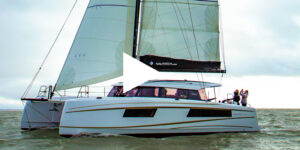
Nautitech 48 Open catamaran – Video

Nautitech 48 catamaran – Interior Design

How the Nautitech 48 catamaran was conceived – Designer Comments.
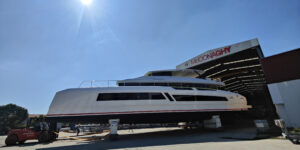
Launched ! – McConaghy MC82P Power
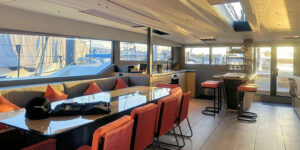
McConaghy 75 catamaran – Stunning NY Loft-Style Interior
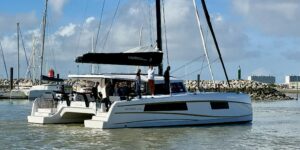
VIDEO: Nautitech 48 catamaran walkthrough. Part 1. EXTERIOR

VIDEO: Nautitech 48 catamaran walkthrough. Part 2. INTERIOR
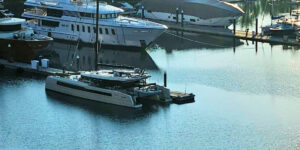
McConaghy 75 Launched.
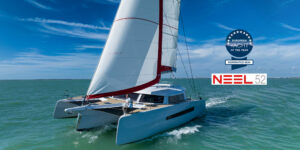
NEEL 52 trimaran nominated European Yacht of the Year 2023
Helpful tips from aeroyacht.
AEROYACHT PUBLICATIONS
Catamaran books by gregor tarjan.

JOIN AEROYACHT’S NEWSLETTER

Which catamarans have daggerboards?
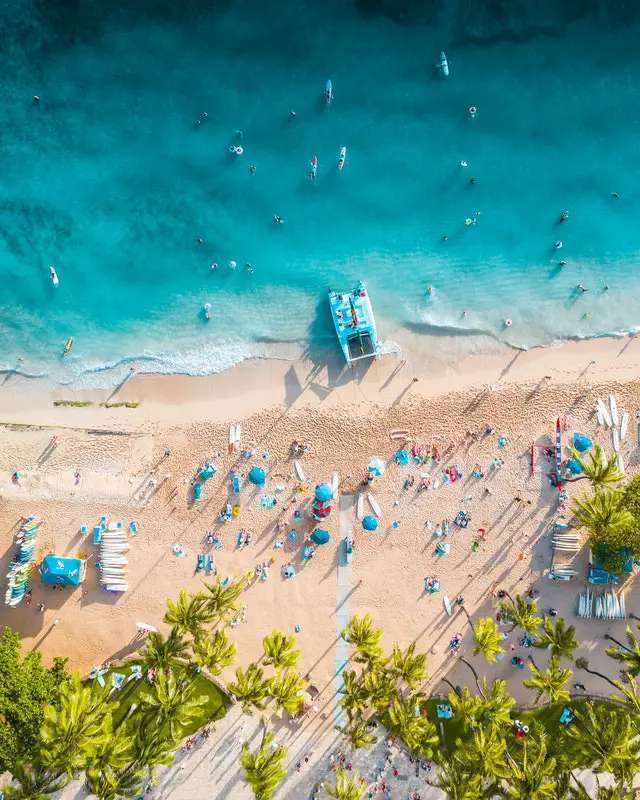
After researching catamarans we have made a list of catamarans with daggerboards. Performance means a great deal for us, so we are looking at the pros and cons of daggerboards, and would like to share our knowledge in this article. If you know of any boats that should be included in this article, please let us know.
Why choose a catamaran with daggerboards?
Daggerboard catamarans are usually higher performing than those without. Not only because of the daggerboard itself but due to the specific focus on performance especially in these types of vessels.
Usually, that focus also makes them lighter as the shipyards have tweaked the materials used to make them light. Often they are designed by the most renowned experts to make the best hulls.
The most important reason to choose daggerboards is performance. They sail closer to the wind when sailing upwind, and they are usually faster than those who focus more on comfort.
Not that daggerboard cats are uncomfortable, but the daggerboard compartment takes up a bit of space from the living area inside the hulls. And you will have to decide if it is worth the decrease in comfort compared to the enhanced performance.
Another reason for choosing daggerboards is the possibility to anchor on shallow waters, as when the daggers are lifted, the draught is often around 3’ or 1 meter or even less.
Catamarans with daggerboards
A list of catamaran models with daggerboards:
- Sud Composites
- Soubise / Freydis – Tournier Marine
French-built catamaran. Well sailing and luxurious.
Also French catamaran. Reviews are pretty good. Easy sailed.
Brazilian built catamaran from 2013. Only this model has daggerboards.
designer Philipe Pouvreau. 30 of them were built before 2008, and after that, a dozen more were built in various custom shipyards. One should therefore be aware of eventual modifications or deviations in the design of the later models.
But the quality is still great, also on the late models, and they have successfully circumnavigated, and are still.
Founded by Alan Adés in 1990, and in 1999 they signed with VLPL, a group of Architects who specialized in multi-hull designs for the competition.
This resulted in the Switch 51, a very well-performing catamaran, which amongst others are known for very decent speed in even moderate wind speeds. They did however not build that many, before switching to building custom catamarans.
Three main models, are still in production:
Soubise 49 Croiseur Soubise 56 Soubise 70
Is not very well known, 27 feet
- Scionning Known to be very high performance.
Benefits of having daggerboards on a catamaran
High performance (speed and efficiency in various wind directions. Especially in upwind directions.)
Can utilize shallow waters, with the boards raised. Typically 3 feet or even less, which means that you can anchor away from the crowd and walk ashore.
Generally, you will have much more anchorage space to choose between.
Disadvantages of daggerboards
More work, more to know and learn, their place in the boat may limit the comfort.
Costly. Adds around 30.000 $ to the construction price.
Why choose daggerboards over fixed keel?
The choice of having daggerboards is mostly a compromise between comfort and performance. Daggerboards make the cat able to sail closer upwind, and the boards are made to enhance the speed.
Boats with fixed keels are sometimes slower, usually also heavier, but also more comfortable, as they have more living space. And if you are sailing short passages, the heavy boat is a good choice.
But if you are going to cross the oceans, the difference in performance is remarkable. It can be several weeks longer crossings compared to higher performing cats.
Daggerboards are for sailors who expect to make longer passages, and who have some experience sailing.
Related Posts
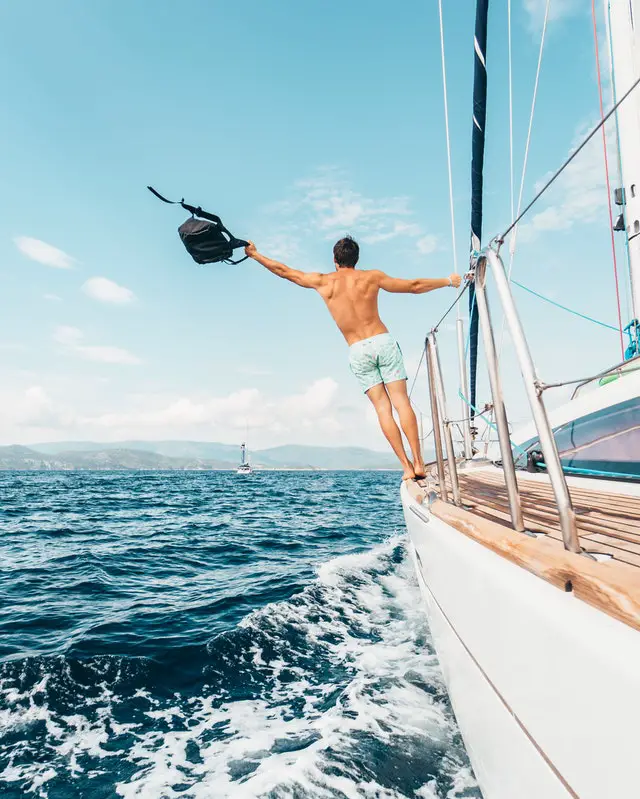
Should you own or charter a boat?
I could give you many reasons why not to buy a boat, but they would be the same reasons not to have a child. Unknown…
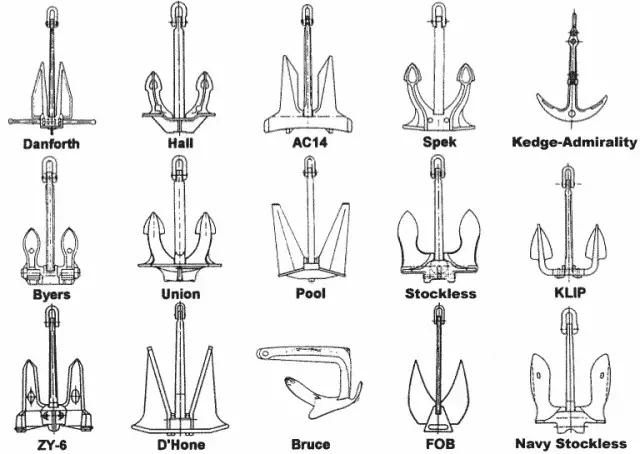
How Anchors Work and All You Need to Know about Anchoring
In this article, you will not only learn all the basics about anchors. You even get all the more advanced knowledge you need about how…
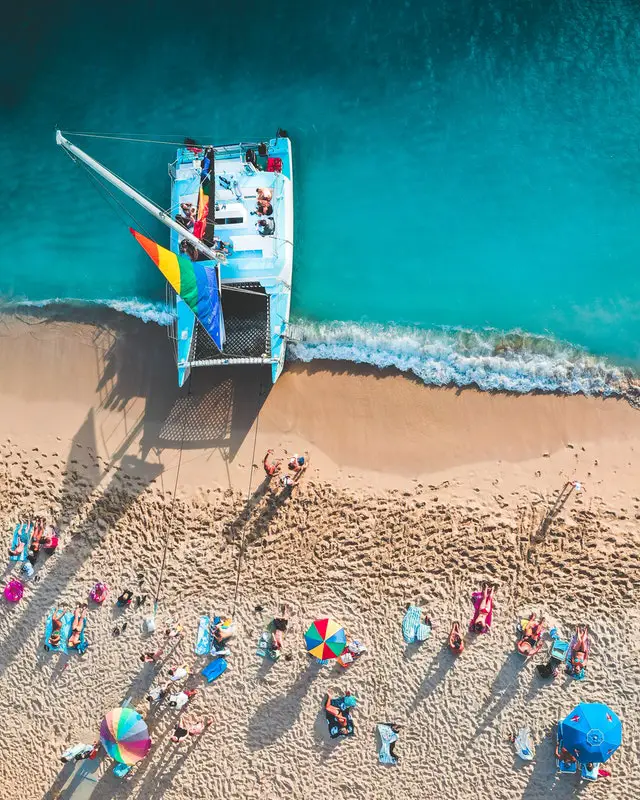
Why catamarans have trampolines
There are several reasons why trampolines are the right choice in catamaran design: It is lightweight, give little resistance to wind and water, is comfortable,…
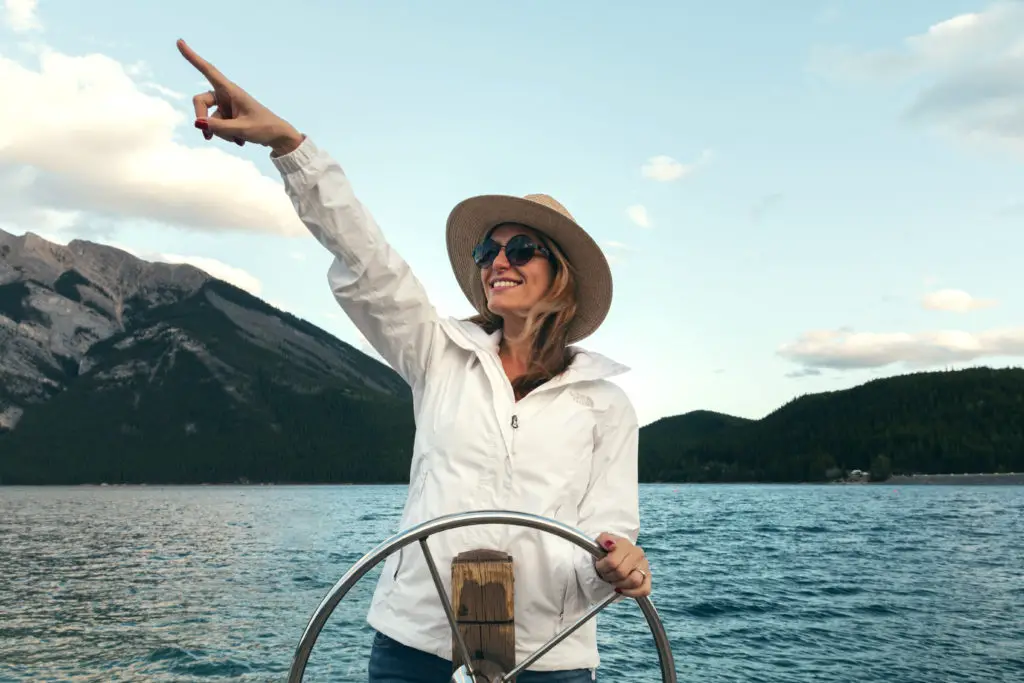
Tips for new sailors in 2022
Are you considering taking up sailing, then you may wonder if sailing is a dying hobby? In this article, we would like to answer some…
Explain The Hydrodynamics Of A Daggerboard
1.1 Brief Introduction to Hydrofoils
Foils (hydrofoils) are important components of sailing craft. These are wing-like structures, located below the surface of the water, which are designed to have high lift to drag ratios (L/D). The hulls to which they are attached rely on both dynamic and static (buoyancy) forces to support them and their performance is usually defined in terms of the resistance-displacement ratio (e) which is the inverse of L/D. The L/D ratio of well designed hydrofoils is much higher than 1/ e of most hulls when both are travelling with sufficient boat speed for dynamic forces to dominate. As a result, at these speeds hydrofoil support is known to reduce total hydrodynamic resistance.
The same basic principles apply to airfoils and hydrofoils ¿ind so a lot of the terminology is shared. As a result, the force resulting from pressure distribution acfps^ the rcSE directed perpendicular to the direction of flow and in the plane of the foil cross-section is called thcj lift force.^This may result in some confusion when it comes to hydrofoils as the main axis (root to tip) may be directed ve> tically for some hydrofoils, resulting in the lift force acting in the sideward direction. The force in theSLrg.ction S flow is termed the drag force.
Conventional sailing craft have predominantly vertical, symmetric foils while hydrofoil supported craft have predominantly horizontal asymmetric foils which raise the hulls out of the water. Symmetric foils will, at zero angle of attack, have similar pressure distributions on both sides when deeply submerged, and when acting at an angle of attack provide a lift force. They are therefore used to provide resistance to lateral movement (daggerboards, keels, centreboards, fins and skegs) and directional control (rudder) while minimizing drag when positioned vertically.
On the other hand, asymmetric hydrofoils provide a perpendicular (lift) force when at zero angle of attack and are designed to provide maximum lift with minimal drag for a range of angles. In order to differentiate a bit better the asymmetric foils are also called 'lifting foils'.1
Another aspect to mention about hydrofoils is that the lift they produce is reduced as they near the free surface (within about 1 chord length). This is known as free surface effects and the implication of this is a natural
1 See Chapter 4.1 for a more in-depth explanation of lifting hydrofoils stability, not only in terms of heave but also in pitch and roll. This will be discussed in more detail in section 3.3.1.
1.2 Catamarans and Sailing Catamarans
"From early European explorers' descriptions, the crew sailed with families, friends, lovers, singers and dancers in one joyous group from island to island - a marvellous way of life." - James Wharram [WB91]
The word catamaran is derived from the Tamil word kattumarum which is composed of the words 'to tie' and 'tree'. [Bir03] This comes from it's origins in the east as primitive canoes used for fishing. The concept is to use 2 demi-hulls fixed in parallel to provide a very stable (in roll) vessel while maintaining slender, low wetted surface area (WSA) and therefore low drag hulls. (See figure 1.1 below)
As shall be explained shortly, roll stability is very important for sailing vessels as they need to resist large heeling moments induced by the sideward component of the aerodynamic force on the sail. A catamaran is naturally stable due to its laterally placed buoyancy and is therefore superior in that regard to monohulls. The WSA of a monohull is less for a particular length and displacement than a catamaran of the same length and displacement. This can be demonstrated using a simply analogy of 2 half cylinders compared to one larger half cylinder of same total volume2. Modern sailing monohulls however, gain their heel stability from the introduction of a heavy keel. A catamaran on the other hand has no need for this heavy keel and will therefore displace far less and sit relatively higher than a monohull, thus countering this effect. From practical experience the reduction in wave drag due to reduced displacement and smaller angles of entry for a given sail area dominates over slight increase in viscous drag due to small increase in WSA (see Appendix B), making sailing catamarans faster that their monohull counterparts. As the catamaran heels, the WSA will decrease rapidly as the windward hull emerges (see Appendix G) therefore also reducing the viscous drag.

water level
• i* /ll* C 1 \ C • 1 i
Figure 1.1 - Front view (-making from bow) of a simple catamaran water level
Figure 1.1 - Front view (-making from bow) of a simple catamaran
2 A more accurate comparison of slender hull WSA is made in Appendix B, using the formulae taken from [DL01]
Another difference is that catamarans tend to be less manoeuvrable as the resistance on the demihulls is far from its centre of rotation and they also have high rotational (yaw) inertia.
In order to model a sailing boat accurately, an understanding of the forces acting on it must first be established. The sails act either as wings in the vertical plane or as 'bags' that absorb the momentum of the passing air. There is therefore often a sideward component to the thrust force acting on the sails. This is undesirable and is therefore countered by an equal hydrodynamic force resulting from the high lateral resistance (mostly on the daggerboards and rudders). The alignment of the hydrodynamic and aerodynamic forces is important in maintaining directional control of the boat and will be discussed in more depth in section 1.3.
One of the fundamental differences between sailing catamarans and power catamarans is the location of the thrust force. For sailing cats, the thrust force acting on the sails will act at their Centre of Effort (CE) and the method for determining this is laid out by Larsson et al. [LE02]. Since this position will be elevated above the hydrodynamic forces, the result is that the forward component of the thrust force results in a pitching moment (nose down) and the sideward component results in a heeling moment (to leeward). Since catamarans have slender hulls with little buoyancy near the bow, the pitching moment makes them susceptible to pitchpole. The
($r aerodynamic side force causes the boat to drift sideways, resulting in a slight angle of attack of the boat with its direction of movement (leeway angle). This in tiîrn causes! a hydrodynamic side force on the foils (rudders and daggerboards) and hull which apposes the aerodynamic foijccp.

Fig 1.2 - Top view of the aerodynamic and Fig 1.3 - Rear view of the aerodynamic and hydrodynamic forces on a sailing hydrodynamic forces on catamaran (Taken from [Shut05(ii)] ) a hydrofoil supported sailing catamaran
The direction of the wind onto the sail is affected by the speed of the boat. A vector addition of the boat speed and true wind speed results in the apparent wind over the sails. In Figure 1.2, the concept of apparent wind and the aerodynamic and hydrodynamic forces are shown. In figure 1.3, the sideward components of the aerodynamic and hydrodynamic forces are shown to produce heel, which in turn creates a shift in centre of buoyancy towards the leeward hull, which creates a righting moment. The lifting foils are also included and their stabilising effect, due to surface effects is also illustrated. A more complete description of the balance of forces and moments may be found in Chapter 16 of [LE02] but the additional effects of the hydrofoils are not included in this.
1.3 The Balance of Sailing Boats
An important factor in a sailing boat design is balance, i.e. balancing the hydrodynamic and aerodynamic forces to ensure yaw stability of the boat. The following is explained by Larsson et al. [LE02] in more detail, however figure 1.4 a) and b) below show the case of how these forces are aligned (designed for low heel) and become unbalanced as a result of large heel angles. This imbalance is then compensated for with rudder angle and is experienced as weather helm. Varying the ruader angle rea ces or increases the amount of side force (lift) generated on the rudder and therefore s.|. fts tl,j CLR forward or aft respectively, thus realigning the experienced as weather helm. Varying the ruader angle rea ces or increases the amount of side force (lift) generated on the rudder and therefore s.|. fts tl,j CLR forward or aft respectively, thus realigning the
![Figure 1.4- Cat at small (a) and large (b) heel angle (modified diagram from [Shut05(ii)]) Daggerboards Catamaran](https://www.schoonerman.com/images/1488_12_8-daggerboards-catamaran.jpg)
In the case of monohulls, the COD moves sideways very slightly (as apposed to the large sideways movement of the CE) with heel and so the yawing moment created and the resulting weather helm will be significant above say 15 degrees. For catamarans, the Centre of Drag (COD) moves further sideways (to leeward) with heel and therefore the range of heel angles for which catamarans don't experience significant weather helm is much larger than for monohulls. This has significant implications with regard to pointing ability and handling, but that lies beyond the scope of this study. It is important to note that as the boat heels, the force vector on the sails gains a vertical component and thus sinkage is increased with heel, while forward thrust is reduced.
1.4 Types of Hydrofoils & Configurations
1.4.1 Foil Arrangement
The use of a single lifting foil (unifoil) has been used with a certain amount of success in the past. For the case of a large amount of loading on the foils however, the boat becomes unstable (like a sea-saw) it is therefore advantageous in terms of pitch stability (especially for sailing craft), to support the boat with two or more foils. Since two foils provide the least amount of interference between foils and are the simplest, configurations of this sort are fairly common. The two foil configuration can be subdivided into three further categories, based on loading of the foils. (See figure 1.5)

Figure 1.5 - The Canard, Aircraft (HYSUCAT type) and Tandem Configurations
• The Canard Configuration has a main foil just aft of the COG and thus provides most of the lift. A front or canard foil is situated near the bow and provides balance and pitch stability.
• The Aircraft Configuration is almost the opposite of the canard and the main foil is situated just in front of the COG with the rear foil providing the pitch stability.
• The Tandem Configuration has two foils which support the boat fairly evenly in terms of lift and distance from the COG.
1.4.2 Surface Piercing and Fully Submerged Foils

Figure 1.6 - Surface piercing foil configuration of Figure 1.7 - Fully submerged, incidence controlled
Mayfly [Cha00] foil configuration. [Cha00]
Surface piercing foils are foils which have their root at the free surface and are characterised by a reduction in wetted area as the foil rises out of the water. This is achieved by angling the foils down when moving abeam towards the centreline along the horizontal plane and this angle is known as the dihedral angle. An added advantage is that due to this angle, the foil will provide additional natural heave, pitch and roll stability. This will be discussed in more detail in Chapter 3.3.3. Figure 1.6 is the foil configuration taken from 'Mayfly7 where the main foil is a surface piercing foil and the rear foil is a standard T-foil on the rudder. (Refer to Appendix A, Figure A.3)
Fully submerged foils are almost exclusively found in a horizontal plane. Typically they are T-foil in nature but for large foils, multiple struts are used and their placement affects the aspect ratio (to be discussed in 3.3.4). Figure 1.7 shows an example of fully submerged T-foils.
1.5 Operating Regimes of Hydrofoil Assisted Craft
The operating regimes of hydrofoil assisted craft in general terms consist of three phases of operation, depending on displacement Froude numbers (Fnv). Migeotte [Mig01] provides a good explanation of the three phases of hydrofoil support - namely: Displacement, Transition and Planing. Figure 1.8 shows the kind of trends and boundaries of the three phases that are to be expected for a hydrofoil supported craft. The exact shape of the curves depends on the hull shape and the size of the foils i.e. relative amount of load that they carry.
Drag vs Froude number (disp)
Displacement Trans Planing

-•-Without hydrofoil
With hydrofoils
Figure 1.8 - Resistance trends to be expected on hydrofoil supported craft.
Trends were observed from results taken from [Mig01]
• The Displacement Phase is characterised by strong wave making patterns and very little rise. The foils provide veiy little lift as the velocity is insufficient to provide a strong lift force (see Chapter 3, equation 3.1) and since they are adding to the WSA, usually increase the total hydrodynamic resistance. Lift is mainly provided by the hull in the form of buoyancy. A main foil spanning the tunnel between the demihulls may also serve to reduce vase making resistance through wave cancellation of the foils and the demihulls. There is a displacement h|ump at around Frv = 1.5 but this is normally only significant for heavily loaded hulls. This is not the case fo^sailing craft.
• The Transition Phase is characterised by a marked reduction in resistance as the foils begin to lift the hull clear of the water. The wave making is also reduced and at a particular Fnv the total hydrodynamic resistance drops to below what was experienced at lower Fnv. This is known as the transition hump speed. The characteristics of the curve are determined by the balance in dynamic forces (suction due to hull shape and hull foil interaction) and the lift of the foils. Aspects of hull shape are discussed in Chapter 2.3.
• The Planing Phase is when the boat is almost fully supported by foils and the remaining hull lift is primarily due to dynamic (planing) effects. The wave resistance is almost zero and the resistance begins to increase with increasing Frv again because no more of the hull can be raised out of the water while the drag on the foils is increasing.
1.6 A Brief History of Hydrofoil Supported Sailing Catamarans
The concept of using hydrofoils to improve the performance of sailing craft has been around for many years. A good background into the development of the hydrofoil supported craft is given in the history section of the website for the hydrofoil supported trimaran L'Hydroptere [The95]. Another good reference for an historical review of the development of fast sailing yachts is an article entitled 'Greed for Speed' in Yachting World Magazine [YW02], where the development of the hydrofoil supported catamarans 'Mayfly' and 'Icarus' is described. Patents for hydrofoil supported sailing boats were found dating as far back as 1955 [Gil55], where a sailing catamaran dinghy was modified to operate with hydrofoils. (Refer to Appendix A, Fig A.1) In fact this 1955 configuration is an almost direct conversion from aircraft to sail craft, where the control system, seating position and trim and lift controls are identical.
Despite all of this development, it was noted that none of the companies listed on the internet that produce sailing catamarans in South Africa, employed any form of hydrofoil support system.
It was also noted that the bulk of hydrofoil assisted boats that are being tested at present are either tested at prototype level, without the assistance of rigorous towing tanl tests (due to availability) or the test data was not made available. It would therefore be very useful to the South African Boat Building Industry for such an
investigation to take place.
In Appendix A, figures A.1-5 gives some examples Qjf .the many hydrofoil assisted sailing catamarans found on the internet. Figures A.6-8 provides examples of other types of sailing craft that make use of hydrofoil support and Figure A.9 demonstrates an alternative use for a hydrofoil (as a paravane which improves the performance of the boat by countering the heeling moment rather than reducing the hydrodynamic resistance on the hull)

after beam main foil
Figure 1.9 - Canard configuration of 'Twin Ducks' [KHKOO]
The success of the examples given in Figures A.1-8, demonstrates that the principle of using hydrofoils to reduce the total hydrodynamic resistance can be applied to sailing boats and there are some important factors regarding these designs. All of the examples of hydrofoil supported craft had some form of trim and ride height control included in their design and had an aircraft type configuration, except the Miller Hydrofoil Sailboard (fig A.8) and the 'Twin Ducks' (fig A.5), which have canard configurations and the Miller Hydrofoil Sailboard relies on free surface effects to provide pitch and heave stability. Icarus, Mayfly and L'Hydroptere have surface piercing main foils - which provide additional heave and roll stability while the rest are fully submerged, although the 1955 patent has a slight dihedral angle on the main foil purely for roll stability.
From this we can deduce that the aircraft type and canard configurations, with surface piercing and fully submerged foils both with and without trim and ride height control, have all been used with a certain amount of success. The most popular combination seems to be an aircraft configuration with a surface piercing main foil and some form of trim and ride height control.
![Figure 1.10 - Pictures of boats with aircraft type configuration, surface piercing main foil, trim and ride height control. Icarus (left) [Gro87] and L'Hydroptere (right) [The05] Aircraft Canard Figure](https://www.schoonerman.com/images/1488_12_14-aircraft-canard-figure.jpg)
As can be seen in figure 1.11, the weight of the crew on a hydrofoil supported dinghy has a large influence on the COG. This allows for more freedom in terms of foil loading. Another thing to note about dinghies is that they have high sail area to displacement ratios and are therefore good candidates for lifting hydrofoils. For example, the boat that was ultimately used for this project was 37 foot catamaran and had a ratio approximately half of that of 'Mayfly'.
1.7 The Concept
Research into the HYSUCAT or Hydrofoil Supported Catamaran (motorised) has been conducted at the University of Stellenbosch for over 20 years [Uni06]. Based on the success of the research conducted on the HYSUCAT and other power boat craft, the concept of this research is to investigate the feasibility of using the HYSUCAT (aircraft type) configuration, which has no trim and ride height control, on a sailing catamaran that best represents those being produced in South Africa. The concept will be tested using towing tank tests of an appropriate model and verified computationally. Once the model has been tested with and without hydrofoil support, the practicality of the foil system can be assessed and any modifications made. Once a suitable hydrofoil support system has been established, the resistance characteristics of the boat with and without 'lifting' hydrofoils will be compared and the imp'revomers (if ®ny) commented on. During testing, no attempt will be made to test a control system (trim and ride height). It is hoped that this will not be necessary, given the correct configuration, but this may be proven otherwise.
![Figure 1.12 - Diagram of HYSUCAT [Cae06] daggerboard catamarans](https://www.schoonerman.com/images/1488_12_16.jpg)
Given that a standard sailing catamaran has rudders near the stern and daggerboards are amidships, it would make sense to attach foils to these. If lifting foils are placed elsewhere they would require additional struts which in turn would upset the balance of the boat, thus requiring a redesign in terms of balance. Placing foils on the rudders and daggerboards would therefore allow for a simple 'add-on' hydrofoil design. The longitudinal centre of gravity (LCG) is intuitively expected to be not far aft of the main foil thus we would have an aircraft type configuration with most of the load on the main foil and as a result, poor pitch stability. Since pitch-pole is a problem for sailing catamarans, the stability of this configuration may not be suitable without the LCG relatively far aft or a trim control system.
The daggerboards provide an excellent platform for the attachment of a main foil spanning the tunnel and the rudders are suitable for rear T-foils. The idea is that the main foil being near the COG will provide most of the support while the rear foils provide the pitch stability. This configuration would not interfere significantly with the balance of the boat at low heel angles and the foils are placed in relative safety (against impact or entanglement) below the tunnel of the boat. Since the main foil will be no deeper than the daggerboards, if impact occurred with a sandbank or any submerged body, it is likely that it would have occurred in any case and the same can be said of the rear foils and their attachment to the rudders.
Since the span of the tunnel of sailing catamarans is usually quite large compared to power craft, a relatively high aspect ratio foil (very efficient - to be demonstrated in 3.2.1) could be placed between the daggerboards.
A problem with ending the main foil at the daggerboards is that there is a bending moment on the daggerboards which could be counter-balanced by extending the main foil beyond the daggerboards. (As in Appendix A, Figure A.1) The problem with that is that the main foil is no longer protected within the tunnel of the boat and despite the increase in aspect ratio, there will be more interference drag with the daggerboards due to twice as many 'corners'. (See Chapter 3.2.4)
1.8 Objectives of the Thesis
The main objective of this thesis: To design a hydrofoil system without a trim and ride height control system and investigate the change in resistance of a representative hull across a typical speed range as a result of the addition of the hydrofoil system, while retaining adequate stability.

The following secondary objectives were also identified so that the validity of the results is ensured and a greater understanding of the dynamic effect of adding the hydrofoils will have on the performance of the sailing catamaran.
1. To find a representative hull of sailing catamarans produced in South Africa, so that the results of this research could be applied to most sailing catamarans produced in South Africa and to establish an appropriate speed range for that hull across which it is to be tested.
2. To test and explain the resistance characteristics of this hull.
3. To find a suitable configuration of lifting foils for this hull that would not require any form of trim or ride height control to maintain stability throughout the speed range.
4. To test and compare the resistance characteristics of the representative hull with and without the assistance of lifting foils. This is to be tested concurrently with point 3 so that a configuration which provides a reduction in total hydrodynamic resistance across a maximum portion of the speed range may be achieved while maintaining stability throughout that speed range. 5. To test and explain the effects of leeway and heel on the performance of the boat both with and without the assistance of lifting foils and draw conclusion as to how this would affect the overall performance of the boat. Since these aspects are significant in sailing boats, their effect on total hydrodynamic resistance will need to be considered and the effect of adding the hydrofoils on these aspects will also need to be considered.
1.9 South African Sailing Catamaran Representative
In order to establish the size of a suitable representative Sailing Catamaran produced in South Africa, a search was conducted over the internet so that a survey of most South African sailing catamaran building companies could be conducted. 23 Companies were found, producing 38 sizes of Catamarans. Figure 1.13 below shows the histogram of these sailing cats.

Q ^ +J ' ' ' ' ' +J +J +J +J ' +-1
OLno^OLnoLnoLnoLn t-t-oioicoco-^-'jrLnLncDCD
Fig.1.13 - Histogram of Sailing Cats produced in South Africa
From this it was decided that any sailing catamaran in the range of 35 to 44 foot Over-all Length (LOA) would be suitable. The dimensions of a hull produced in South Africa, which fits into this range, are provided in table 1.1 below. These dimensions were used as a representative sailing catamaran which formed the basis for investigations carried out in this project.
Table 1.1 - Basic parameters for representative hull (See appendix C for more details)
Continue reading here: Hull Hydrodynamics and Design
Was this article helpful?
Related Posts
- Nomenclature - Catamaran Sailing
- Hydrofoil Applications - High Speed Sailing
- Appendages - Catamarans Guide
- High Speed Sailing - High Speed Sailing
- Centerboard version of the Seafarer K
- Daggerboards - Catamarans Guide
Readers' Questions
What is a dagger board?
A daggerboard is a retractable centerboard that helps stabilize and improve the sailing performance of a sailboat or a windsurfing board. It is typically made of a solid flat piece of material, such as wood, plastic, or composite material. The daggerboard is inserted into a slot in the hull of the boat and can be raised or lowered as needed. When lowered, the daggerboard extends beneath the boat, acting as a keel or a centerboard, providing lateral resistance to prevent the boat from sliding sideways and improving its ability to sail upwind. When raised, the daggerboard is retracted into the hull, reducing drag and allowing the boat to sail more efficiently in shallow waters or when not needed for stability.
- » Events
- » WW2 Timeline
- » 30 Nov 1941
- Whitley bombers of No. 502 Squadron RAF based in Northern Ireland, United Kingdom attacked German submarines U-71 and U-563 with depth charges in the Atlantic Ocean, damaging U-71. This attack marked the first successful use of air-to-surface vessel radar. ww2dbase [ U-71 | CPC]
- German submarine U-43 sank British ship Ashby 170 miles south of the Azores islands at 1926 hours; 17 were killed, some survived and were rescued by Portuguese destroyer Lima. U-43 survived the subsequent depth charging without any damage. ww2dbase [ U-43 | CPC]
- Comandante Cappellini sighted a British destroyer in the Atlantic Ocean at 0620 hours, followed by another ship shortly after, whose direction led to the Italian submarine submerging. She lost contact with them by 0745 hours. At 0917 hours, another warship appeared; the Italian submarine prepared to attack her with a torpedo, but the ship would turn away before the torpedo was prepared. ww2dbase [ Comandante Cappellini | CPC]
- Morosini sighted a German submarine in the Atlantic Ocean at 1120 hours; they exchanged information by megaphone. ww2dbase [ Morosini | CPC]
- Japanese submarine I-10 launched a scout aircraft for a reconnaissance mission over Suva Bay, Fiji. ww2dbase [ Suva | CPC]
- A Soviet force consisted of two destroyers, a troop ship, and other minor vessels arrived at Hanko, Finland to evacuate troops, while another force consisted of troop ship Maya, 3 minesweepers, 2 submarine chasters, and 1 gunboat departed Kronstadt, Russia for Hanko. ww2dbase [ Hanko | CPC]
- German submarine U-206 became missing in the Bay of Biscay, possibly lost in a British minefield just west of Saint-Nazaire, France. All 46 men aboard were lost. ww2dbase [ U-206 | Saint-Nazaire, Pays de la Loire | CPC]
- The Japanese ambassador in Germany Hiroshi Oshima was informed by his superiors that war with the United States was near, and he was to inform Adolf Hitler and Joachim von Ribbentrop of such news. ww2dbase [ Hiroshi Oshima | Berlin | CPC]
- German armed merchant cruiser Komet arrived at Hamburg, Germany after a 516-day, 87,000-mile, circumnavigating journey. She sank 5 ships, captured 1 ship, and shared credit for another two sinkings on this mission. ww2dbase [ Komet | Hamburg | CPC]
- Japanese destroyers Akembono and Ushio departed Tokyo Bay, Japan for Midway, where they were to bombard US military facilities when hostilities would begin. ww2dbase [ Tokyo Bay | CPC]
- Emperor Showa ordered Prime Minister Hideki Tojo to proceed with plans to start the Pacific War, and subsequently Tojo rejected US proposals to de-escalate tension in the Far East. ww2dbase [ Hideki Tojo | Showa | CPC]
- Shoho was commissioned into service. ww2dbase [ Shoho | CPC]
- Latvian and German Jews were massacred near Riga, Latvia. ww2dbase [ Discovery of Concentration Camps and the Holocaust | Riga | CPC]
- New Zealand 24th and 26th Battalions were battered by Axis attacks at Sidi Rezegh, Libya. German forces launched a fresh attack on Tobruk, Libya. Out at sea, British aircraft from Malta sank Italian ship Capo Faro and damaged Italian ship Iseo, which were en route from Brindisi, Italy to Benghazi, Libya; they were carrying fuel and other supplies that were very much needed for the Axis campaign in North Africa. ww2dbase [ Operation Crusader | Sidi Rezegh | CPC]
- German submarine U-96 dove to evade attacks by a British Swordfish aircraft in the Strait of Gibraltar at 2235 hours. ww2dbase [ U-96 | Strait of Gibraltar | CPC]
- Passenger liner President Madison, chartered by the US Navy, arrived at Olongapo, Philippine Islands, disembarking the 2nd Battalion of the US 4th Marine Regiment before continuing on to Singapore. ww2dbase [ Olongapo, Zambales | CPC]
- Field Marshal Walter von Reichenau replaced Field Marshal Gerd von Rundstedt as the commanding officer of German Army Group South in the Caucasus region of southern Russia. ww2dbase [ Walther von Reichenau | CPC]
- The warming of temperature in the region around Leningrad, Russia meant a decrease in the ice thickness over Lake Ladoga, which led to the decrease of supplies delivered by ground vehicles driving over ice; only 61 tons of food made its way into the city on this date. ww2dbase [ Siege of Leningrad | Leningrad | CPC]
- Elements of German 2nd Panzer Division captured the railway station at Lobnya 19 miles north of Moscow, Russia. Meanwhile, Georgy Zhukov was ordered by Joseph Stalin to organize a counterattack. ww2dbase [ Battle of Moscow | Georgy Zhukov | Joseph Stalin | Lobnya, Moscow | CPC]
- Winston Churchill sent Franklin Roosevelt a message requesting a conference on the impending war with Japan. Roosevelt would reject the request to avoid appearing like he was taking the United States toward war for the defense of the British Empire. ww2dbase [ First Washington Conference | Franklin Roosevelt | Winston Churchill | CPC]
- The United States Marine Corps reported the strength of 65,881 personnel. ww2dbase [CPC]
- USS Grayback arrived at Portsmouth, New Hampshire, United States for a scheduled overhaul. ww2dbase [ Grayback | Portsmouth, New Hampshire | CPC]
30 Nov 1941 Interactive Map
Timeline Section Founder: Thomas Houlihan Contributors: Alan Chanter, C. Peter Chen, Thomas Houlihan, Hugh Martyr, David Stubblebine Special Thanks: Rory Curtis
- » WW2DB's 19th Anniversary (29 Dec 2023)
- » Looted Painting "Madonna with Child" Returned to Poland (2 Jun 2023)
- » Wreck of USS Mannert L. Abele Found (29 May 2023)
- » Wreck of Montevideo Maru Found (25 Apr 2023)
- » Accidental Detonation of a WW2-Era Bomb in Great Yarmouth (10 Feb 2023)
- » See all news
- » 1,145 biographies
- » 336 events
- » 43,415 timeline entries
- » 1,237 ships
- » 349 aircraft models
- » 208 vehicle models
- » 372 weapon models
- » 123 historical documents
- » 259 facilities
- » 467 book reviews
- » 28,344 photos
- » 432 maps
The World War II Database is founded and managed by C. Peter Chen of Lava Development, LLC. The goal of this site is two fold. First, it is aiming to offer interesting and useful information about WW2. Second, it is to showcase Lava's technical capabilities.
- » More About WW2DB
- » More About Lava
- » Syndication
- » Terms of Use & Disclosures
- » World War II Database Home
- » Mobile View
- » Today in WW2 History
- » WW2 in Color
- » Battle of Iwo Jima
- » Battle of Stalingrad
- » Normandy Campaign
- » Tiger I Tank
- » The Holocaust
- » Hiroshima and Nagasaki
- » Corsair Fighter
- » Combined Fleet
- » IJN Signals and Doctrine
- » Tully's Port Forum
- » WW2 File Blog
Copyright © 2004-2024 Lava Development, LLC. , all rights reserved

IMAGES
VIDEO
COMMENTS
Having a catamaran with daggerboards means enjoying better pointing ability than an equivalent model equipped with fixed stub keels, which are inevitably shorter. ... Builders such as Outremer provide stopper knots for the daggerboard control lines; a good way to judge the position when the daggerboard is not visible. 7) Once the daggerboard is ...
The best cruising catamarans with daggerboards or centerboards provide great cruising capability, comfortable living, ease of handling, and strong construction. Based on different styles, designs, sizes, and prices, some of the best catamarans are Outremer 45, Catana 50, and Balance 526. If catamaran cruising is a passion you have been longing ...
In very light winds, the standard practice is to lift the windward daggerboard all the way and only trim the leeward board. When both daggerboards are down, (for simplicity) there is now double the 'underwater sail' area. This would likely imbalance how much power there is from the light winds on the sail above the water, and literally ...
The daggerboard is a key feature on catamarans, as it provides lift and stability to the boat. It is located on the centerline of the boat and can be raised and lowered at the skipper's discretion. This allows the skipper to adjust the center of effort on the boat, enabling greater maneuverability and control. ...
The daggerboard is one of the most misunderstood pieces of equipment on a multihull. The reason why cats don't go to wind is actually quite simple. ... half of the fleet, sailing as high as, and faster than the racing keel yachts. On the second leg, I passed more boats including all the multihulls, to finish 20th overall behind the large ...
This catamaran instructional video teaches you how to Use daggerboards on a catamarancome and learn to sail with us! www.adventuresailing.com.au
You could essentially say that a catamaran with keels is a bit like a long-keel monohull, and the daggerboard catamaran is a fin keel monohull in more terms. I think we all know and all agree that the best sailing boats are going to be the one with fin keels. Then progressively a long-keel boat or keel or one with low aspect-ratio keels on the ...
Daggerboards. Do you really need them on a cruising cat? Or is just for all the racers? In the second of our Technical Tuesday series on Catamaran design we ...
First things first - let's understand what a catamaran is. A catamaran is a multi-hulled vessel consisting of two parallel hulls connected by a deck structure. Unlike traditional monohulls, catamarans offer increased stability due to their wider beam. This stability means more balance when sailing through choppy waters or in heavy winds.However, even with their inherent stability advantage ...
Daggerboards. The majority of today's cruising catamarans are equipped with mini keels for reliable and hassle-free operation. There are fewer than a handful of production daggerboard catamarans, which provide the sailor slightly more pointing ability and other advantages as illustrated in previous chapters. Their operation is generally ...
Your sails, keels, daggerboards and rudders when moving forward into the wind create high pressure of the windward side, and low pressure on the leeward side, and the boat is pulled forward, into the wind. Because the foil directs the boat around the curve of the foil, the boat is lifted forward, and to windward. This is also why airplanes fly.
The Prout brothers discovered that in 1953 when they fitted a central board on the prototype Shearwater. By 1954 they had fitted boards in the hulls. The Stiletto catamaran started with a central daggerboard but owners quickly found that converting to ones in the hulls improved performance significantly.
Every single HH Catamaran daggerboard goes into our monster testing jig and we apply the full force of the known working load to fly a hull with two reefs and the two times "dynamic load factor". So, an HH66 board gets tested to a staggering 17,000kg, which is really scary. Even with our new HH50, the boards are tested all the way to 10 tons.
Centerboard. The centerboard is mounted horizontally on a rotating bolt at the foremost part of the foil (keep reading to understand what a foil is). It folds into a comparatively much longer slot in the hull than a daggerboard. A centerboard comes in many different shapes and sizes, it can be combined with an already existing keel, or it can ...
The speed advantage of most daggerboard catamarans vs. keel catamarans though is often exaggerated. On a typical day sail a well trimmed and tuned keel cat will only be slightly slower than a daggerboard cat. Multihulls lack the feeling of being in the "groove", which monohull sailors enjoy.
Daggerboard catamarans are usually higher performing than those without. Not only because of the daggerboard itself but due to the specific focus on performance especially in these types of vessels. Usually, that focus also makes them lighter as the shipyards have tweaked the materials used to make them light. Often they are designed by the ...
1.2 Catamarans and Sailing Catamarans "From early European explorers' descriptions, the crew sailed with families, friends, lovers, singers and dancers in one joyous group from island to island - a marvellous way of life." ... A daggerboard is a retractable centerboard that helps stabilize and improve the sailing performance of a sailboat or a ...
Collin Marshall - Kinetic Catamarans Commissioning Skipper and Sailing Systems, breaks down Centerboards vs Daggerboards. Kinetic has an option for either on the KC62 and KC54, owner preference. ... If a daggerboard struck an object it would endure the full impact force and transfer the load to the bearing box which would result in higher ...
Daggerboard catamarans. I have quite a bit of experience sailing in fixed keel cats (mostly FP and Lagoon) but I am rather new to daggerboard cats. I just had a 1.000 nm with an Outremer 51 and about the same with a Catana 47 Carbon infusion. I learnt that while running or broad reaching they are retracted and leeway is used to yr favor.
30 Nov 1941. Atlantic Ocean. Whitley bombers of No. 502 Squadron RAF based in Northern Ireland, United Kingdom attacked German submarines U-71 and U-563 with depth charges in the Atlantic Ocean, damaging U-71. This attack marked the first successful use of air-to-surface vessel radar. ww2dbase.
NOVA RIGA ISTRA NOGINSK KLIMOVSK LOBNYA SOUTHERN PUSHKINO KREKSHINO SEVER SHOLOKHOVO PULKOVO SHUSHARY GORIGO ROSTOV-ON-DON NOVOSIBIRSK VOLGA PRIMIUM KELLERMANN CONSTANTA. News. 10.04.23 - 24.03.23 - 24.10.22. Raven Russia is the market leader in the logistics and warehousing sector in Russia.
Ukrainian military had 64 combat engagements with Russian forces near Terny and south-east to Vyyimka of Donetsk region, Ivanivske, Klischiyivka, Andriyivka of Donetsk region, Lastochkyne and Pervomayske of Donetsk region, Heorhiyivka, Pobyeda, Novomykhaylivka of Donetsk region, Robotyne of Zaporizhzhia region, at the east bank of Dnipro river in Kherson region, - General Staff of Armed Forces ...
Lobnya. / 56.017°N 37.483°E / 56.017; 37.483. Lobnya ( Russian: Ло́бня) is a town in Moscow Oblast, Russia, located 30 kilometres (19 mi) [7] north west of Moscow. Population: 82,764 ( 2021 Census); [8] 74,252 ( 2010 Census); [2] 61,567 ( 2002 Census); [9] 60,475 ( 1989 Census); [10] 30,000 (1970).